Carl Valentine & I Didn't Clean Ale's Fridge
Saturday, June 30, 2007

My daughter Ale called us this morning at 9. Last night she drove to her new home in Lillooet and arrived at 4 this morning. We spent the afternoon helping her move stuff into her friend Dave's truck and Rosemary, and I cleaned her kitchen, bathroom, etc. During this whole ordeal (and an ordeal it was) I kept thinking of Ale not being near us for the first time in 38 years. Rebecca and Lauren worship her and listen to her gentle admonitions on their behaviour.
We will miss her even though Ale was always very Mexican in her relationship with time. It drives Rosemary crazy that to this day Ale will show up at our door step, spur of the moment, without calling. Ale also retains not only her Mexico City accent but also all the slang words of being a chilanga (Mexico City born).
On the other hand Hilary, who was also born in Mexico City retains a connection with her father's birth in Argentina. She inherited that illogical attraction to soccer that seems to be in our blood. She has always been crazy about Argentina and its performances in the FIFA World Cup. If she didn't have to work today she would be glued as I will to the Under 20 FIFA World Cup on CBC TV when Argentina plays Czechoslovakia.
When Ale called she told us her old place still had some things to pick up and that the fridge had to be cleaned. I went with Rosemary and removed hooks from the wall and emptied the refrigerator. The detritus of someone who has left a house after years of living in it has the power to depress deeply. And this power is double when it affects the ex-tenant's father. I determined then that I was not going to clean the fridge. Rosemary looked at me and said, "I thought your were going to do it." "No, I am going home right now."
All the time I had in mind the idea rustling up the only image in my files related to futbol (soccer). It is my photograph of the handsome, and quiet spoken Carl Valentine who came so many years ago to play for the Whitecaps. I had been assigned in the mid 80s to photograph him for Equity. I also had in mind of sitting in front of my TV to watch the Brazilians play Poland.
I am sure there are many more fridges for me to clean (and Rosemary will do fine without me this time). The depression is beginning to lift and who knows, perhaps Rebecca will inherit something of her mother and she just might want to sit next to me when I watch Argentina this afternoon.
Lance Henriksen - Very Good At Being Very Bad
Friday, June 29, 2007

In November 1997 Globe & Mail writer Chris Dafoe and I spent some time in actor Lance Henriksen's movie trailer. He was in town filming a TV series called Millenium. When we left, after the end of the interview and the photo session, Dafoe commented to me, "What a likeable guy." I could not disagree as I, too, was astounded by Henriksen's hospitality and gentlemanly demeanor. The November piece in the Globe by Dafoe had the charming title you see above for this blog. And it was accompanied by a photo of mine where Henriksen smiled.
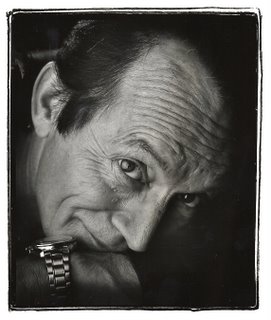
Thinking back on that day and from my perspective of 2007 I realize it all started sometime in 1985 when Vancouver Magazine associate editor Don Stanley told me to photograph a science fiction writer called William Gibson.
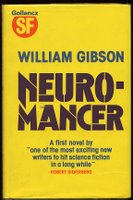
It seems that his 1984 novel Neuromancer had won a science fiction hat trick. It had won the Hugo, the Nebula and the Philip K Dick awards for best novel of that year. I immediately looked for some high technology looking place to photograph the author. I picked Gibson at his Kitsilano home. Getting into my Fiat X-19 presented a problem.My tiny two seater sports car was not able to accomodate his 6ft 5in frame. Gibson ended up with his knees bent to his chin. I took the photo you see here at a new nightclub called Systems that was at the foot of Richards Street. At the time I believed that when one lacked a good photographic idea one resorted (and I did here) to the Dutch Tilt.

Gibson liked his photograph and for many years I was his official photographer. I received calls from Stern, Vanity Fair, Rolling Stone, etc for pictures. But his influence over me (it certainly helped my finances) went beyond. It was from Gibson that I learned to appreciate Raymond Chandler. I remember fondly going to see Terry Gilliam's Brazil with Gibson and John Lekich at the Park on Cambie Street. We discussed the film over coffee across the street.
But it was also Gibson who first told me of American director Kathryn Bigelow and her 1987 vampire western, Near Dark. It was in this scary but wonderful film that I discovered Lance Henriksen.

While this favourite film of mine is one I have only seen once, I do believe I will see it again soon. I will enjoy Henriksen being very good at being very bad.
Death & The Maiden
Thursday, June 28, 2007
The Maiden:
Pass by! Oh, pass by!
Go away, fierce man of bone!
I am still young, go my dear!
And do not touch me.
Death:
Give me your hand, you beautiful and delicate form!
I am a friend, and am not come to punish.
Be of good cheer! I am not savage,
You will sleep softly in my arms!
Death and the Maiden - Franz Schubert
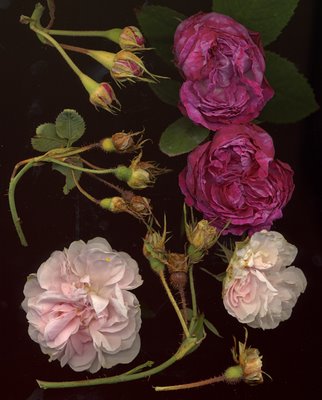
I don't dare buy Reginald Hill's latest The Death of Dalziel (with a far more interesting title in the UK of Death Comes for the Fat Man - Death of Dalziel). I have read all of Hill's Dalziel (pronounced deal) and Pascoe novels and all of his stand alone novels, too (over 25 in all). But I just don't have the nerve to read this one yet to find out as I did with Colin Dexter's The Remorseful Day of the death of the novel's protagonist, Inspector Morse at the end of it.
Only today I made the connection between my sickly Rosa 'Maiden's Blush' and Franz Schubert's String Quartet No 14 (Death and the Maiden) or Schubert's 1817 lied song Der Tod und das Mädchen from which the second movement of that string quartet is based on. When I hear the quartet or the song I brood but I feel nicely depressed. I feel the same when I listen to Miles Davis playing All Blues with that obsessive Paul Chambers bass vamp.
Eight or so years ago I had the last of my terrible weekly migraines. With age I might have outgrown them. I noticed in those last years that I had few migraines in June and July. I quickly found the reason. In June and July I deadhead my roses and fuss over them and smell them. This is so relaxing that whatever stress I had in my system was dissipated by the roses.
One of my favourite Dalziel & Pascoe police procedurals set in Mid Yorkshire is called Deadheads. In this 1983 novel the scene opens with an old woman deadheading roses. She is suddenly aspproached by a young boy. He shows some curiousity so she explains to the young boy, her niece's bastard son, what she is doing:
'Why do you do it?' demanded Patrick.
'Because,'she lectured, 'once the the flowers have bloomed and begun to die, they inhibit - that is to say , they stop - other young flowers from developing and blooming. Also the petals fall and make the bush and the flower-beds look very untidy. So we cut off the blooms. It's called deadheading.'
By the end of that chapter Patrick is being instructed by his great aunt on the art of deadheading. He has posession of the extremely sharp knife.
'Patrick,'she said taking a step back. 'Patrick!'
There was a sting on her bare forearm as the thorns of the richly scented bush dug into her flesh. And then further up, along the upper arm and in the armpit, there was a series of sharper, more violent stings which had nothing to do with the barbs of mere roses.
Mrs Aldermann shrieked once, sent a skinny parchment-skinned hand to her shrunken breast and fell backwards into the rose-bed. Petals showered down on her from the shaken bushes.
Patrick watched, expressionless, till all was still.
Then he let the knife fall beside the old woman and set off running up to the house, shouting for his mother.
This delightful book features chapter titles that are the names of real roses with short descriptions which somehow reveal the action of the chapter. Since Patrick's mother is called Penelope one of the chapters is appropriately called Penelope, a hybrid musk rose. But the ones that made me laugh are Dandy Dick (the first chapter): Floribunda. Clear pink, erect carriage, almost a Hybrid Tea. And the last chapter, when all the loose ends are resolved, is called Félicité Et Perpétue.
All the above has a connecting purpose. I have two favourite roses, Rosa 'Maiden's Blush (also called Cuisse de Nymphe Emu, Incarnata, La Virginale, La Séduisante) and Rosa 'Reine des Violettes'. Both have a fungus disease called Botrytis cinerea. After struggling for five years to check the disease I have come to the conclusion that these two roses in our wet spring weather are pre-disposed to Botrytis and I must uproot them and throw them away. Even today (check the picture above) amongst all the yellowing and aborted buds, both roses produced a few beautiful and fragrant blooms. I have another Maiden's Blush in a different section of the garden that is fine so I don't feel as terrible a pang about doing in my maiden. I recently purchased a clean Reine des Violettes and she will replace my sick one. I am saddened. If you consider all the other names Maiden's Blush has you have to realize that she does seduce.
But at least when I am deadheading my roses with my secateurs I need not watch my back.
More secateurs
Zemblanity, Moscato & William Boyd
Wednesday, June 27, 2007
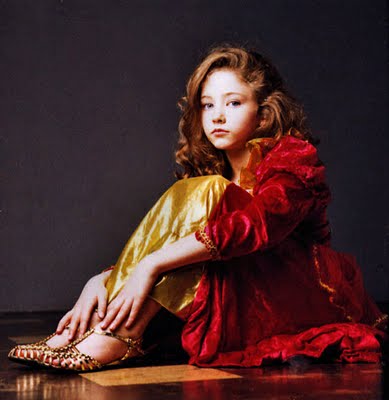
I believe I am beginning to understand that children now are different from children then (my time). While I was thrilled at Gene Kelly's swordfighting skills and mesmerized by the beautiful but evil Lana Turner as Milady in The Three Musketeers Rebecca did not understand what was going on and soon got bored. We switched off the TV. Yet a couple of years back we had enjoyed Gunga Din. I have postponed indefinitely what I think should be a child's passage into early adulthood. This would be the watching of Gary Cooper in Beau Geste. Would I be able to take in stride my disappointment if Rebecca would be bored by it? I saw Beau Geste for the first time at the General Paz in Buenos Aires with my father and mother. I was 8 or 9. Could it be possible that she would not be thrilled by the burning of the toy ship in the Geste garden pond?
Yet three years ago Rebecca, Rosemary and I sat a block away from the General Paz in on Cabildo Street. We were eating on a sidewalk table the marvelous pizza at Burgio. It was a very hot Buenos Aires evening. It was 11:30pm. Rebecca asked me what I was sipping. I was sipping moscato which is a very sweet (it tastes of pure grape juice) wine that is served ice cold. Argentines of back then still indulge in this unlikely combination of sweet wine with pizza. This unlikely combination is uncommonly good. Rebecca asked me if she could have some. I passed her the glass and she had a couple of sips which she said she enjoyed. Perhaps my right of passage through Beau Geste with my father and mother somehow has the parallel with Rebecca sipping her moscato at 11pp in a hot Buenos Aires Evening.
As a child my grandmother (below, right) often told me of equally hot evenings in turn-of-the-20th century Manila. She told me of the old Spanish quarter called Intramuros (within the walls) and how people dressed and flirted with their Spanish fans.
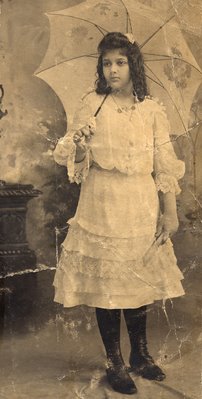
She told me of going to little establishments to sip on ice cold horchata. This is a Spanish non alcholic beverage made from sugar, coconut, rice water and almonds. The beverage was acccompanied by ensaimadas which were pastry (very soft and spongy) that was made by twisting the batter (left to rise often) in a nautilus swirl. I enjoy a close approximation of horchata by buying the Italian version called horzata. I buy the syrup in Italian stores. At Goldilocks, on Fur and Broadway, I get the ensaimadas (spelled enzaimadas by the establishment's Filipinos). All I lack to go back to that turn-of-the-century and heavily Spanish influenced Manila is to read one of my favourite books. This is The Blue Afternoon. That the book would be written by a Ghana born Englishman, William Boyd is sort of strange. My Rebecca would not understand that this child (then) would instantly equate William Boyd with Hopalong Cassidy. Luckily I discovered this writer some years ago and I am a reader of his novels. I can tell you that Boyd coined the word zemblanity which is the opposite of serindipity. Boyd defines it as, " The opposite of serendipity, the faculty of making unhappy, unlucky and expected discoveries by design."
The Manila book by Boyd is a time machine into my grandmother's past. I can easily cite it as one of my ten favourite books from my collection. It involves an architect, a surgeon and a some early fliers who may have preceded the Wright Brothers. Reading about Manila at the turn of that century is like listening to my grandmother talk in her Castilian accent. But it is the killer prologue that kills me every time I read it.
Last week on Saturday afternoon I asked Rebecca to turn of the TV and we sat in the living room while I read to her:
The Blue Afternoon
William Boyd
Prologue
I remember that afternoon, not long into our travels, sitting on deck in the mild mid-Atlantic sun on a slightly smirched and foggy day, the sky pale washed-out blue above the smokestacks, when I asked my father what it felt like to pick up a knife and make an incision into living human flesh. He thought seriously for a while before replying.
'It depends on where you cut,'he said.' Sometimes it's like a knife through clay or modelling wax. Some days it's like cutting into a cold blancmange or... or cold raw chicken.'
He pondered pondered a while longer and then reached inside his coat pocket and drew out a scalpel. He removed the small sleeve that protected the blade and offered the slim knife to me.
'Take this. See for yourself.'
I took the scalpel from him, small as a pen but much heavier than I had imagined. He looked down at the remains of our lunch on the table: an edge of cheese with a thick yellow ridn, a bowl of fruit, four apples and a green melon, some bread rolls.'
'Close your eyes, 'he said. 'I'll get something for you, an exact simulacrum.'
I closed my eyes and gripped the scalpel firmly between my thumb and first two fingers. I felt his hand on mine, the gentle pressure on his dry rough fingers, and then he lifted my hand up and I felt him guiding it forward until the poised blade came to rest on a surface, firm, but somehow yielding.
'Make a cut,'he said. 'A small cut. Press down.'
I pressed. Whatever I cut into yielded easily and I moved the blade down an inch or so, or so it seemed, smoothly, with no fuss.
'Keep your eyes closed....What did it feel like?'
I thought for a second or two before replying. I wanted this to be right, to be exact, to be scientific.
'It felt like....Like cold butter, you know, from an icebox. Or a sirloin, like cutting through a tender sirloin.'
'See?'he said. 'There's nothing mysterious, nothing to be alarmed about.'
I opened my eyes and saw his sqare face, smiling at me, almost in triumph, as if he had been vindicated in some argument. He was holding out his bare left forearm, the sleeve of his coat and shirt pushed back to the crook of his elbow. On a bulge of muscle, six inches above his wrist, a thin two-inch gash oozed bright blisters of blood.
'There, 'he said. 'It's easy. A beautiful incision. Not a waver, with even pressure and with your eyes closed, too.'
The expression on his face changed at this moment, to a form of sandness mingled with pride.
'You know,'he said, 'you would have made a great surgeon.'
----------------------------------------------------------------------------------------------------------------------------
Only later in the book did I find out (with a shock) that the above scene is between a father and daughter.
Alexandra's Spade
Tuesday, June 26, 2007

The story really began when my daughter Alexandra was born in Mexico City 38 years ago. I will skip all that.
Two years ago we suddenly found ourselves the owners of two exquisite hardwood handled stainless steel garden spades. For years I had been using cheap spades ignoring the common sense of not applying too much leverage. I have broken many. I decided then to purchase a good one. So did Ale (Alexandra) who had noticed my track record. I felt saddened that Ale had spent at least $65 on the spade but there was no way I could tell her I already had one. The problem of an extra spade was soon solved when I broke my own. It did not break at the handle. A section of the stainless steel blade simply sheared off.
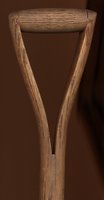
I continued working in the garden with Ale's spade. After using it to pry a large stone to bury our white cat Polilla in the garden I broke the handle off. The solution was simple. I went to 16th Avenue and Dunbar garden repair shop, the one with the nasty old woman who overcharges. Her shop is the last place left in our area that repairs garden equipment. The good handle from one spade was put into Ale's spade. A couple of months ago I broke it.
I was determined to end the folly. At Lee Valley Tools I bought a fibre glass handled spade with a lifetime guarantee. I looked at Ale's spade sadly and put it away.
Ale is moving to Lillooet this Saturday to live. For the first time in 38 years we will not have her living a few blocks away. Rosemary is upset. So am I but I try to hide it. Ale is moving to a 3/4 acre property. We suspect her house is a shack. She is taking most of her plants.
A couple of years ago Ale gave me the rugosa rose, Rosa 'Hansa'. This extremely hardy rose would grow well in Lillooet's Zone 4. But I could not uproot Ale's gift to me. Luckily I found another classic rugosa, Rosa 'Belle Poitveine' at the UBC Botanical Garden shop. Today I took Ale's spade to be repaired at the 16th and Dunbar shop. The old lady has softened up since she came down with Parkinson's. I explained I wanted the spade repaired, no matter the cost. I told her about Ale and Lillooet. She looked at me and with a smile on her face she said, "It will be ready by Friday."
I hope that Ale's spade will serve her well and that when Rosa 'Belle Poitevine' blooms next year she will remember that we love her.
Ale, I wish you all the best in your new adventure. If you break the spade, don't throw it away. I'll have it fixed.
The Reverend J.H. Pemberton and Erskine McPherson's Buttonhole
Monday, June 25, 2007
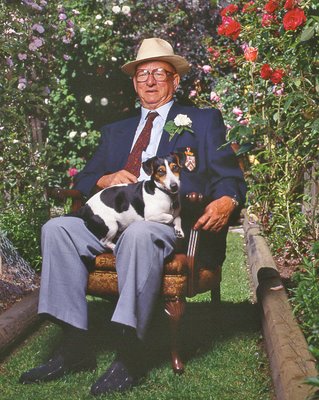
A couple of years ago I walked into McLeod's Books on West Pender and spotted Reverend Joseph H. Pemberton's Roses - Their History, Development And Cultivation. It was a 1908 first edition. Many of the pages had not been cut. This meant that the book had probably never been read. Trying to give my friend and owner of the used book store, Don Stewart my best poker face I asked him for the price. He said, "$50.00 but for you it will be $40.00." I could have sold the book to a collector for $200 that same day but I would never sell this treasure. In the early 20s Pemberton introduced a new class of roses (the first of the modern rose shrubs) that featured smallish flowers but that compensated by being extremely fragrant and which grew in large clusters. Pemberton called them Hybrid Musks.
Pemberton's (1852-1926) account on how he first became interested in roses is enough reason to want to keep it. Here it is:
My early recollections of church-going are associated with roses. We went every Sunday morning to an old Queen Anne church: ours was a square pew; the pew opener, a woman, walked before us, opened the pew door and shut us in. We sat round facing one another, but could not see anything except the gallery having the royal arms in the centre, the children who sat there with the village schoolmaster, who was also parish clerk and gave out the hymns. When standing-up time came I had to stand on the seat to see over the top of the pew. In a neighbouring pew there was a gentleman who appeared every Sunday with a rose in his buttonhole; I admired that rose and resolved to wear as good if not a better one the next Sunday. During the week I was on the look-out for a suitable one, and when Sunday came again it was gathered – Moss, White-crested Moss, Red Provence at first and then Baron de Maynard or Boule de Neige were favourites. I appeared with my bloom, and when the time came to mount the seat compared it with the rose in the buttonhole of the rival. The result of the judging was usually adverse to me, but I always went home hoping for better luck next time. My flowers were handicapped by the staging; you see I was in petticoats at first and wore a light-coloured Norfolk jacket, large mother-of-pearl buttons down the front and a belt. My rival had a black coat, and the rose had a buttonhole all to itself; there is nothing like black to set off a rose, specially when added to this the flower did not have to share the buttonhole with a large button. I was quite aware of the drawback, and longed for the time when I might have a cloth jacket with a buttonhole on the side.
---------------------------------------------------------------------------------------------------------------------------------
Apart from the autobiographical gem from his book, I have been unable to find much information on the Reverend Pemberton, who was born in Essex and lived there most of his life. He died in 1926, one year after he hybridized one of his most popular roses, Rosa 'Cornelia'. Here you see a scan of my specimen. Cornelia's blooms are smallish but they come in giant clusters. Best of all, besides having that odd but attractive moschata (musk) fragrance, she is extremely shade tolerant and disease resistant. I have also been unable to find any image of Pemberton.
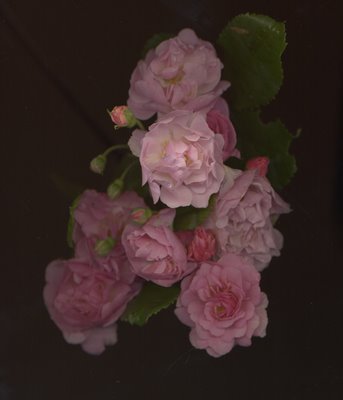
When Rosemary first took me to a Vancouver Rose Society meeting some 15 years ago I suffered on the hard chairs and the interminable projection of bad rose slides. The only light moments of those evenings were provided by a giant and bald old man with a booming voice. Erskine McPherson had the driest and most wonderful humour and could really grow roses. In the picture above, which I took a few years before his recent death you can spot the rose in his lapel and his beloved Jack Terrier, whose name was Jack. With no existing image of the Reverend Joseph Pemberton it is not too hard for me to imagine that the Reverend Pemberton and Erskine McPherson perhaps looked the same.
Another of my Pemberton favourites is Rosa 'Penelope' and Rosa 'Bishop of Darlington'. Of the latter I wish I could find out who the man was and why Pemberton would dedicate and name a rose after him.
A Shropshire Lad
Sunday, June 24, 2007
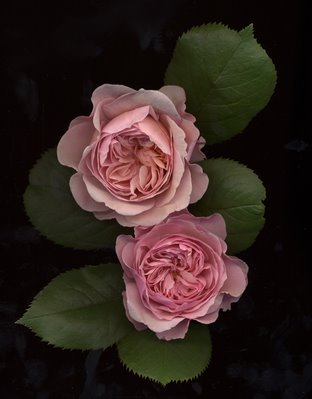
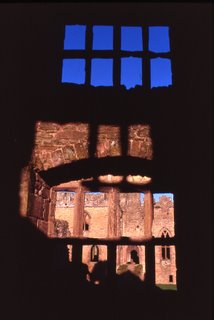
English rosarian and hybridizer David Austin has named a few of his English Roses after locations and people who lived in Shropshire. There is a red rose called Wenlock and my beautiful pink rose seen here, Rosa 'A Shropshire Lad'. I also have the pale yellow Mary Webb and a rose that perhaps A. E. Houseman would have ignored, Rosa 'A Shropshire Lass'. I took the photographs below at Stokesay Castle and at Ludlow Castle. For some unknown reason Rosa 'Brother Cadfael' has been shy in blooming this year.
When I was one-and-twenty
I heard a wise man say,
`Give crowns and pounds and guineas
But not your heart away;
Give pearls away and rubies
But keep your fancy free.'
But I was one-and-twenty
No use to talk to me.

When I was one-and-twenty
I heard him say again,
`The heart out of the bosom
Was never given in vain;
'Tis paid with sighs a plenty
And sold for endless rue.'
And I am two-and-twenty
And oh, 'tis true, 'tis true.
XXIII A Shropshire Lad
A.E. Houseman
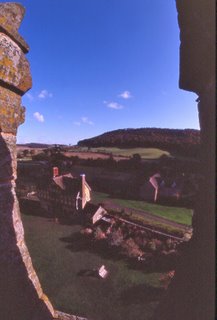

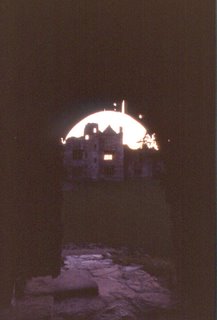
Leonardo Da Vinci & Robertson Davies's Glasses
Saturday, June 23, 2007
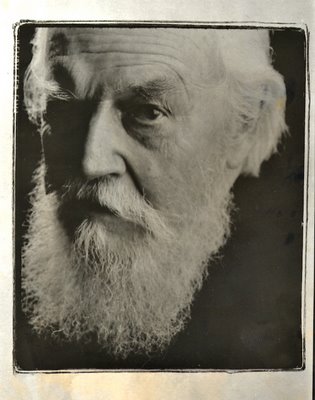
In November 1994 when Robertson Davies posed for me in the Sun Room of the Vancouver Hotel he tried to railroad me into taking his picture with his eye glasses in his mouth.
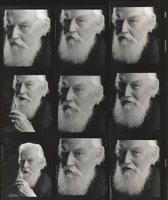
I had seen this photograph many times taken by different photographers all over Canada. Davies always managed to look like the distinguished man of letters we all thought he was. This he was. But in close contact with him in the room, with his charming wife Brenda knitting, the experience was different from what I thought it was going to be. I was a bit intimidated when I walked into the room but in no time Davies had me relaxed.

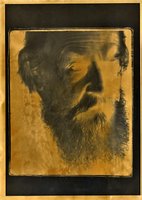
I told him that as I child I had been an admirer of Leonardo da Vinci and I had even copied, with charcoal on paper, da Vinci's self potrait. I told Davies that I was determined to make him look like Leonardo. The process involved taking a normal b+w photograph which I then converted into a b+w transparency (slide). I used some German Uhu glue to stick the b+w slide on my living room window. I then re-photographed this with Polaroid, first in b+w Polaroid and then with colour Polaroid.
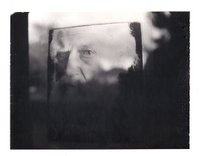
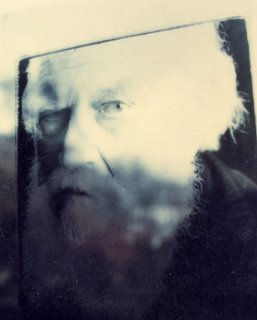
All along the process I felt that somehow I had been in the presence of Leonardo da Vinci, albeit a charming one who spoke beautiful English. A few days later I received a pleasant note from Brenda Davies which included three snapshots she took of me in action. I was thrilled!
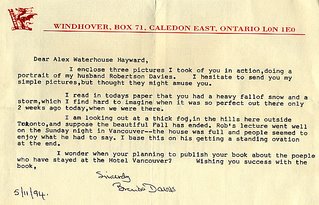
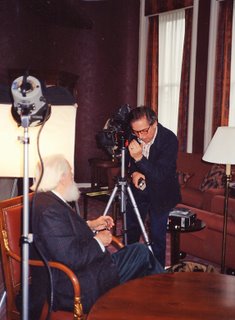
Gene Simmons & Isaac Asimov
Friday, June 22, 2007
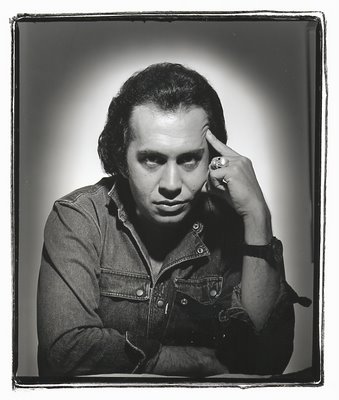
In 1983 when I photographed Gene Simmons I first understood the difference between the actor and the person. Gene Simmons the actor posed for me and scared me to death. He personified evil. Then with a smile in his face he told writer Les Wiseman and me a curious story. While living in New York City this scenario often repeated itself. The door bell would ring. Simmons would open the door to face a couple of geeky teenagers with a question in their face. Simmons would simply say, "Try next door," and would then close the door. Simmons's neighbour for many years was famous science fiction writer Isaac Asimov. The teenagers never suspected who the affable man without makeup really was.
W. H. Hudson's Little Girls
Thursday, June 21, 2007
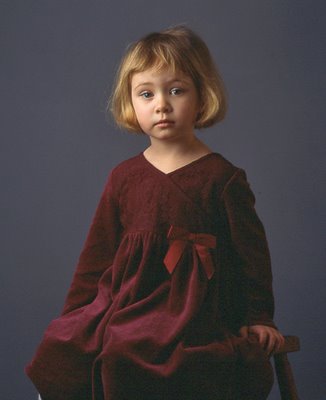
A year before Argentine born William Henry Hudson (1841-1922) died he wrote a book of essays (traveling in England where he lived towards the end of his life) called A Traveller In Little Things. Here is chapter XXI:
Wild Flowers And Little Girls
Thinking of the numerous company of little girls of infinite charm I have met, and of their evanishment, I have a vision of myself on horseback on the illimitable green level pampas, under the wide sunlit cerulean sky in late September or early October, when the wild flowers are at their best before the wilting heats of summer.
Seeing the flowers so abundant, I dismount and lead my horse by the bridle and walk knee-deep in the lush grass, stooping down at every step to look closely at the shy, exquisite blooms in their dewy morning freshness and divine colours. Flowers of an inexpressible unearthly loveliness and unforgettable; for how forget them when their images shine in memory in all their pristine morning brilliance!
That's how I remember and love to remember them, in that first fresh aspect, not as they appear later, the petals wilted or dropped, sunbrowned, ripening their seed and fruit.
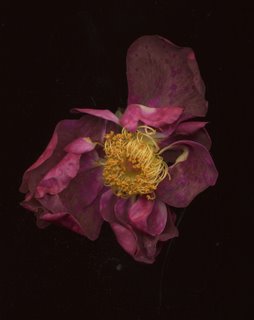
And so with the little human flowers. I love to remember and think of them as flowers, not as ripening or ripened into young ladies, wives, matrons, mothers of sons and daughters.
As little girls, as human flowers, they shone and passed out of sight. Only of one do I think differently, the most exquisite among them, the most beautiful in body and soul, or so I imagine, perhaps because of the manner of her vanishing even while my eyes were still on her. That was Dolly, aged eight, and because her little life finished then she is the one that never faded, never changed.
Here are some lines I wrote when grief at her going was still fresh. They were in a monthly magazine at that time years ago, and were set to music, although not very successfully, and I wish it could be done again.
Should'st thou come to me again
From the sunshine and the rain,
With thy laughter sweet and free,
O how should I welcome thee!
Like a streamlet dark and cold
Kindled into fiery gold
By a sunbeam swift that cleaves
Downward through curtained leaves;
So this darkned life of mine
Lit with sudden joy would shine,
And to greet thee I should start
With a cry in my heart.
Back to drop again, the cry
On my trembling lips would die:
Thou would'st pass to be again
With the sunshine and the rain.
W.H. Hudson goes on to write in Chapter XXIII
A Spray Of Southernwood
To pass from little girls to little boys is to go into quite another, an inferior, coarser world. No doubt there are wonderful little boys, but as a rule their wondefullness consists in a precocious intellect: this kind doesn't appeal to me, so that if I were to say anything on the matter, it would be a prejudiced judgment. Even the ordinary civilized little boy, the nice little gentleman who is as much at home in the drawing-room as at his desk in the school-room or with a bat in the playing field - even that harmless little person seems somehow unnatural, or denaturalized to my primitive taste. A result, I will have it, of improper treatment. He has been under the tap, too thoroughly scrubbed, boiled, strained and served up with melted butter and a sprig of parsley for ornament in a gilt-edged dish. I prefer him raw, and would rather have the street-Arab, if in town, and the unkempt, rough and tough cottage boy in the country. But take them civilized or natural, those who love and observe little children no more expect to find that peculiar exquisite charm of the girl-child which I have endeavoured to describe in the boy, than they would expect the music of the wood-lark and the airy fairy grace and beauty of the grey wagtail in Philip Sparrow.........
--------------------------------------------------------------------------------------------------------------------------------
I had these stories in mind yesterday as I sat on my bench gazing at Rebecca, her friend Britany, Lauren and Tim Bray and Lauren Wood's little girl. We were having iced tea, Filipino ensaimadas and polvorones, watermelon, melon and grapes in our sunny afternoon garden. My granddaughter Lauren (she is going to be five this Sunday) was blowing soap bubbles by the centre rose bed. I could not get enough of her (above left in her wine coloured dress and below being made up for that photograph by Ale my eldest daughter).
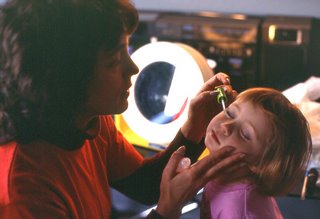
When my daughter Hilary was pregnant for the second time I would tell her (I may have been almost serious) that if she had a little boy I was going to disown her. Luckily Lauren was a little girl and I never had to carry out my threat. I honestly would not know how to deal with a little baby boy. After all, I have two daughters and never wanted a son. I don't particularly care if I am the last of the Waterhouse-Haywards.
I think of W. H. Hudson's stories and wonder how they would be read in our overly cautious 21st century? Would any monthly magazine have published that story of the little girl?
I can't get enough of my little girls. I guess that I can write about them and how I feel here and be safe. I have the protection that being a grandfather provides. I believe that W.H. Hudson wrote from an innocent heart in more innocent times and while he would have been pilloried now for what he wrote then, he was lucky to have been a man of his time. Perhaps, he may have even been lucky enough to be a grandfather.
And perhaps, if Hudson had cultivated a rose garden he would have come to appreciate the beauty in the faded glory of the rose. Seen here is a spent bloom of the Gallica rose, Rosa 'Alain Blanchard'.
Kate & Anna McGarrigle At The Holiday Inn Steps
Wednesday, June 20, 2007
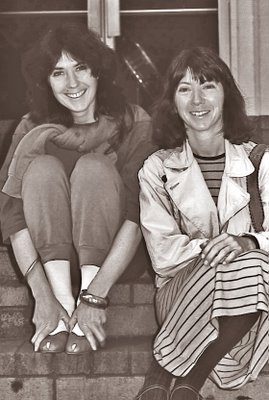
In my first year in Vancouver in 1975 I worked for Tilden Rent-A-Car. When I answered the phone (I was promoted from washing cars to the counter desk in 4 months) I had to say, "In Canada it's Tilden, may I help you?" I learned lots at Tilden. I learned not to rent to black people or native people as they were bad risks. I broke this rule a few times and the cars disappeared and I was almost fired. But I did learn a few useful things. In jockeying cars from our downtown location on Alberni Street (across from the Ritz Hotel) to the airport I discovered Vancouver's few shortcuts and back alleys. I have a very good Vancouver GPS in my head thanks to Tilden. While I didn't feel part of Vancouver that first year at least I got to know it well.
A few days ago I was walking west on Helmcken Street and when I arrived at the corner with Howe, I cut through the hotel courtyard of the Holiday Inn that is there. As I walked south on Howe, I saw a step well and I suddenly felt a tingling of memory in my head. I knew I had been near it. I instantly remembered I had photographed the McGarrigle sisters on it sometime in the late 70s.
I can understand how butterflies and birds find their way. They have a more advanced body GPS than I do. I can be driving through some street in Vancouver when I might not have driven through in years and something in my head tells me that I have been there before. It is nothing paranormal. It's just my brain's ability to seek and find coordinates in time and place.
As a 8-year old boy I remember when my mother could not return with me in the train from Belgrano to Coghlan (one stop) at the end of a school day on those special days she had to stay at school for meetings. She would put me in the train and Mercedes, our housekeeper waited for me at the other end usually with a Noel chocolate covered vanilla "Revello". When I traveled alone on the train I looked out of the window and noticed the neighbourhoods and their streets. Once without my mother's permission I took that train alone and walked from the Coghlan train station home (6 blocks). I arrived without getting lost and was given a spanking for my efforts. I feel that thanks to this childhood "roaming" I have a keen sense of direction and I know where I am at most times.
I worry about Rebecca who is picked up, delivered here and there and rarely walks in her neighbourhood. When she is in the car with me and we are near her house I ask here where she is. She usually does not know. So I have been teaching her a bit about the streets of Vancouver. Rosemary's new Audi has a compass that is built-in the rear view mirror. Rebecca and I have been talking about sur and norte and oeste and este. She is getting her bearings. We have to make up for lost time. One day I will take her to the Holiday Inn stepwell and tell her the story of the McGarrigles.
Mary Magdalen (e)
Tuesday, June 19, 2007
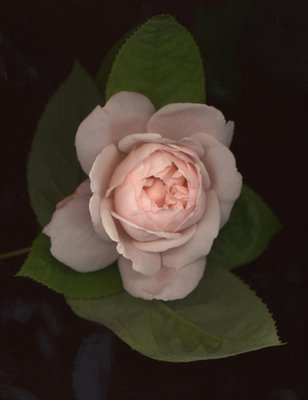
He suspects the woman is a prostitute, not because he is particularly good at guessing people's professions at first glance, besides, not that long ago he himself would have been identified as a shepherd by the smell of goat, yet now everyone would say, He's a fisherman, for he lost one smell only to replace it with another. The woman reeks of perfume, but Jesus, who may be innocent, has learned certain facts of life by watching the mating of goats and rams, he also has enough common sense to know that just because a woman uses perfume, it does not necessarily mean she is a whore.
The Gospel According to Jesus Christ
José Saramago translated from the Portuguese by Giovanni Pontiero
------------------------------------------------------------------
Much has been written lately about Mary Magdalene. If that name has an e or not is one of the matters in dispute between the universities of Oxford and Cambridge, where the colleges dedicated to her bear the rival spellings. To my granddaughter Mary Magdalene is very real. But this Mary Magdalene is many Mary Magdalenes. She is Rembrandt's The Woman Taken in Adultery and John the Evangelist's unamed woman of Verse 7:53-8:11 where he relates Jesus having a confrontation with scribes and pharisees over whether a woman accused of adultery should be stoned.
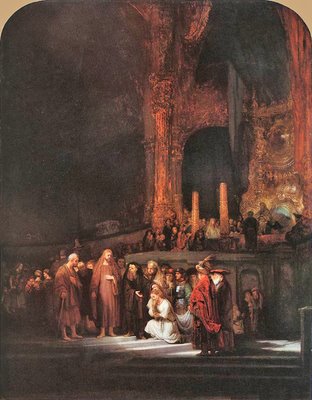
Traditionally Mary Magdalene has also been the Mary of Bethany who annoints Jesus's feet with oil using her hair and the first person to see Jesus after the crucifixion. It's all a muddle if you consider that we cannot prove that John the Apostle is John the Evangelist! But from my New American Bible (with Rembrandt's paintings and sketches illustrating it) I quote one of the most fascinating passages. I first learned about them from Brother Edwin Reggio CSC in the late 50s in Austin Texas. The passages (when Jesus saves the adultress from stoning) describe the only two occasions when we learn that Jesus perhaps knew how to write.
Jesus bent down and started tracing on the ground with his finger. When they persisted in their questioning he straightened up and said to them, "Let the man among you who has no sin be the first to cast a stone at her." A second time he bent down and wrote on the ground. Then the audience drifted away one by one, beginning with the elders. They left him alone with the woman, who continued to stand there before him. Jesus finally straightened up and said to her, "Woman where did they all disappear to? Has no one condemned you?" "No one, sir," she answered. Jesus said, "Nor do I condemn you. You may go. But from now on avoid sin."
Magdalene is real to Rebecca since we saw the extremely large painting inside the church of San Cayetano in Guanajuato, Guanajuato, Mexico two years ago. She was so taken by the 19th century painting that featured a blonde (just like Rembrandt's) Mary Magdalene facing Jesus and with a prominently large stone at her feet. What was about to happen was graphically ominous. We had to return twice to see the painting. Back in Vancouver I bought Rebecca the English Rose, Rosa 'Mary Magdalene' seen above.
All this brings to mind one of the most exquisitely written novels on the subject, José Saramago's The Gospel According to Jesus Christ. I have the novel in Spanish, El Evangelio Según Jesucristo (1991) but I dared not translate some of he passages from the chapter where an 18 year-old Jesus spends 8 days with Mary Magdalene in fear of not doing justice to Saramago. After all Giovanni Pontiero (from Manchester!) was (alas he died) one of the most lucid translators of Saramago into English. So this morning I went to the Vancouver Public Library to get a copy in English.
After they had eaten, Mary helped Jesus into his sandals and told him, You must leave if you're to reach Nazareth before nightfall. Farewell, said Jesus, and taking up his pack and staff, he went out into the yard. The sky was covered with clouds as if lined with unwashed wool, the Lord must not be finding it easy today to keep an eye on His sheep from on high. Jesus and Mary Madgalene embraced a long time before exchanging a farewell kiss, which did not take long at all, and little wonder, for kissing was not the custom then.
The Gospel According to Jesus Christ
José Saramago translated from the Portuguese by Giovanni Pontiero
Bill, Bob, Mike & Jack & The Boys From St George
Monday, June 18, 2007

Objectivity is a subjective invention of man.
Santiago Genovés Tarazaga
In November 1983 writer Don McLellan and I were sent by Vancouver Magazine editor, Malcolm Parry, to St. George's, the Vancouver private school, for a story that made the January 1984 cover. At the time I remember that Don McLellan wore torn jeans ahead of the fashion trend of later years. He wore torn jeans because he was poor. Facing rich kids at a private institution that almost guaranteed that those who graduated would have a certain prosperous future amongst the social elite of our city made McLellan ill disposed to write positively of the school. I sensed this and I believe that was the first time in my photographic career that I determined that whatever objectivity had guided me before had no say here.
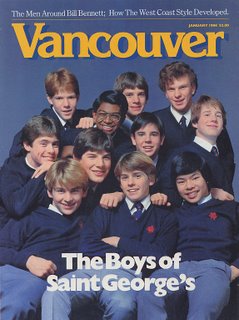
I consciously took photographs, with a definite positive bent, that were to "balance" McLellan's writing. I had attended a Catholic boarding school in my youth and the experience had been a positive one. I liked private schools.
Later that year I took photographs of Mayor Mike Harcourt. Vancouver Magazine art director, Chris Dahl, asked me to photograph him sitting in a wing chair and wanted the photograph full frontal with plenty of room all around. He told me he was going to put it on the cover. He never told me his complete plans. In an age before Photoshop Dahl had an artist paint obvious hair on Harcourt's very bald head and when the magazine was on the newstands it caught me by surprise.

Harcourt never blamed me for this and our relations have been cordial all these years. I have photographed him for his campaign poster when he was running for premier and recently I took the first photographs of his early attempts at walking after his accident.
In April 1985 I headed to Victoria in a float plane with Equity editor, Harvey Southam. He interviewed Bob Skelly who was then leader of the NDP. Subsequently I photographed Skelly for his campaign to become premier (he lost). I had an admiration for this honest man who looked great in shark skin suits and looked at you in the eye when he talked to you. But I sensed a lack of passion and perhaps that's what did him in.
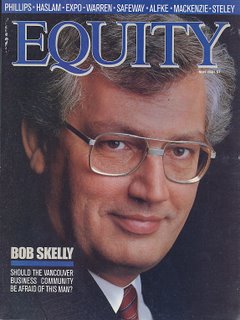
In December 1985 I was asked to photograph Premier Bill Bennett for the Equity cover. I was given 30 minutes by Bennett's assistant. I decided to take a make-up artist (Inga Vollmer) who would probably use up most of that time. I thought that makeup would work wonders on the man and I would then quickly shoot him in 5 minutes. I will never know what led me to chose a portable pink velour backdrom for the picture.

I had read bad stuff about Bennett in the newspapers and I had seen his wooden performance when facing a TV camera (except the time I caught him enjoying a not so friendly sparing with Jack Webster). I was prepared to dislike the man but I vowed to make him look as good as I could. I have always thought that it is the obligation of a photographer to do just that.
The day of the shoot with Bennett came and I was most nervous. Vollmer and I were whisked into Bennett's Vancouver office (at Robson Square). We were both instantly charmed by him. We quickly found out that in a one-to-one basis Bennett was not wooden. He was intelligent and we left loving the man.

Photoshop was still not available. I had to shoot with colour negative so that the resulting C-print (colour print) could be air brushed. And it was. Vollmer said of Bennett's face, "I never expected to see all the colours of a Persian carpet on a man's face."
William Gibson - Pater Familias
Sunday, June 17, 2007

In the May 1986 Vancouver Magazine I had a feature article called Sequels of literary parents who had written about their offspring. When I asked William Gibson to be part of my project he not only posed with his son Graeme and a hard copy of his Hugo award, but he also wrote a beautiful little essay on a father's love for a son.
------------------------------------------------------------
"I was an only child, both parents dead. Kind of like being the sole survivor of some drowned Atlantis; nobody else remembers. The way back, it turns out, is to have your own kids. As a kind of bonus, you get to figure out all the kid stuff you might have missed on the way up. Like I'd only ever known how to make this one kind of paper airplane, a really clumsy one that didn't fly very well. So I started buying Graeme books with instructions for different planes. Now he knows about 20 different folds: darts, canards, flying wings, tiny little origami numbers that imitate swallows, step-discontinuity airfoils that I still haven't learned how to make...We fly them off the front porch, they get caught in trees, I knock them down with sticks. Truly the basic stuff of sanity."
William Gibson
My Father George
Armand Jean du Plessis
Saturday, June 16, 2007
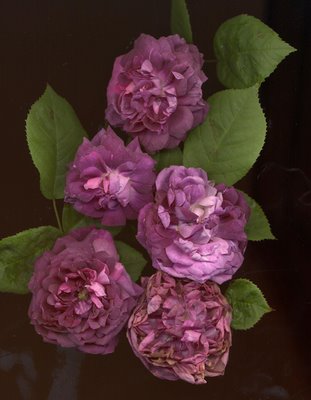
I pointed at the purple Gallica in my garden and told Rebecca yesterday that it was Rosa 'Cardinal de Richelieu'. Her answering question, "Who was he? Is he dead?" means that this afternoon Lauren, Rebecca and I are going to watch George Sidney's 1948 The Three Musketeers. In spite of everything that has been said and written about the sophistication of director Richard Lester's subsequent versions of the Alexandre Dumas novels, this Technicolor Hollywood production is my fave.
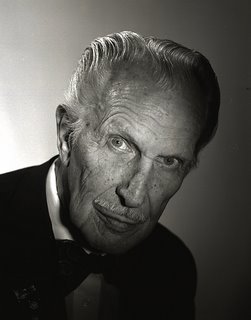
Nobody could possibly out do Vincent Price as the villanous cardinal (made villanous by Dumas). Gene Kelly is a delight as the handsome young fourth musketeer. But the treasure of this film is Lana Turner as Milady. I would affirm that if there is no protagonist in literature with fewer redeeming qualities than Milady. I would have to search in Cormac McCarthy's Blood Meridian for a an equal match. Lana Turner plays the role so well that in the end (I was 10 when I saw this film) I almost cheered as I imagined her head being chopped off by the Executioner of Lyon. Lana Turner was never more beautiful. As much as the bra was one of many anachronisms of the film, I don't think an anachronism was ever better served.
This purple Gallica (with an extremely sweet old rose scent) in my garden was hybridized in 1840, 200 years after the Cardinal's death. There are conflicting opinions if M. Laffay of Bellevue, France or the Dutchman Van Sian should get the credit for this rose that sometimes gets so close to being blue as it fades with age. In my scan here you can see a spent bloom on the bottom right.
That a rose, like so many others steeped in history, can help to make a Saturday with my granddaughters an excuse (with no guilt) for such fun as sitting down to watch one of my favourite films, has to be all the rationale needed to grow them.
Bars, Drinking, My Father & Les Wiseman Remembers Motorhead
Friday, June 15, 2007

I would sit at the bar and Jorge, the Mexican barman would smile with a, "Que tal," and place a large glass of soda water in front of me. This was the Marble Arch Hotel, which had a stripper joint. The room was L-shaped. From my vantage point I could barely see the talent on stage. It was here that I pretended that I was Humphrey Bogart (Jorge didn't even have to ask me, "The usual?") in one of his early movies.

I could go to this bar, or the Drake, the Number 5 and Gary Taylor's and never have to pay for a drink even though my favourite was always soda water. It was at the Marble Arch with Jorge where I would glean information of Vancouver's underworld, a world that few ever read about in the newspapers.
Recently my youngest daughter Hilary reminded me (I was trying to explain to her the importance of culture) that it was not always so with me.
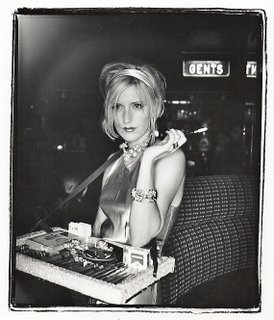
"You should get down from your culture high horse Papi. I remember when you used to go to listen to punk bands in bars with Les Wiseman and drank beer while Ale (my oldest daughter) and I were home watching TV." I tried to deny that I ever drank beer. But Ale did remind me that there were a few times (she remembers only two) where I arrived home late and made noisy use of the toilet.
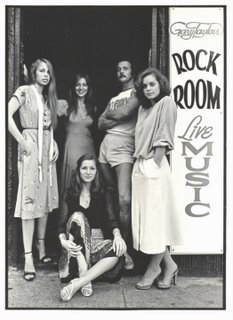
My friend John Lekich could write and has written beautiful romantic pieces on the lore, culture and mystique of good bars. In fact the photograph of Jim Byrnes having a chat with the barman of Gerrard's is at a place (never a joint for John) that is John's favourite bar of Vancouver.

For a long time I attempted to live this lore of the bar with Les Wiseman but I could never get past the two beers that either triggered a migraine or nausea. But I learned plenty from Les. I became a musical snob and with Les I have had drinks with such musical stars as Sting and Lenny Kaye to Art Bergmann. It was with the latter that I remember once going to the Number 5 where at the time they had a most agressive waitress who asked us if we wanted more beer. We told her we had no more money. She said, "Look in your pockets and scrounge some change." We did. We put the coins on the table. She scooped them up and then placed a pint on the table and gave us two extra glasses. "Share that," she said and was gone.
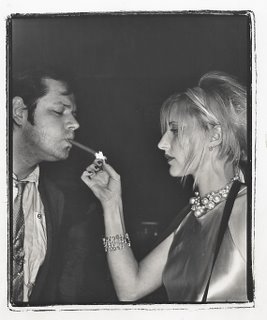
I remember the first time I got drunk. I was a boarder at St Edward's High School at Austin, Texas and I was in grade 11. My room mate, Maurice Badeaux was out on a date on a Saturday night. He kept a bottle of bourbon in his desk. I removed it and drank up and then got in bed to see what would happen. It was rapid oblivion and all I remember was being pulled to the floor and then kicked in the ribs by an irate Maurice, " You SOB, you drank all my liquor!" I can safely say that I got drunk maybe four more times in my life and I remember the circumstances for each case of which I will not bore you here. But I do remember the first bar I ever entered.
When I was 9, I had my first communion at the Nuestra Señora del Carmen chapel, around the corner on Roque Pérez in Buenos Aires. When the nuns came to collect our contributions, my father who was drunk, placed a package of Volpi, tangerine flavoured lozenges in the basket. I was ashamed. A few months later my father, George, voluntarily left the house. He would come to visit twice a month. In one of those visits he took me to Schubert House on Rivera Street.That is when I first got a whif of that smell that defineds all bars from the most sophisticated to the least. I remember going up a spiral staircase on to the upper floor. A pianist and violinist were playing a tango. My father proudly introduced me to them. I was so blond then, that the pianist told my father, “Your son looks German.” My mother was furious with George when she found out he had taken me to a bar. I didn’t see him for a long time. Of all of my father’s visits I remember best when he took me to the General Paz Theater on Cabildo Street to see Beau Geste with Gary Cooper and Ray Milland. It was only recently that I saw Ray Milland in Billy Wilder's The Lost Weekend with horror. The movie brought memories of my childhood. My father was an alcoholic who came from a family of alcoholics. My first cousin, Rollo Barber (who had a fondness for directing symphonic music played on his record player, much in the same way that others play air guitar) could hold a lot of liquor. It is because of this family history that I have never really enjoyed bars. But circumstances have made me go to many bars and there are quite a few memories that are pleasant.
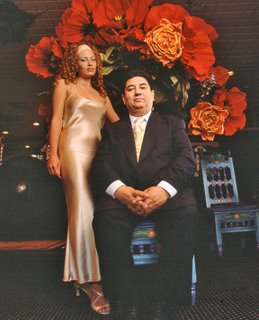
I used to frequent Ferydoun Manavi's Uforia, across from the Gerrard Bar on Burrard. Manavi, an Iranian, did not drink but had Vancouver's finest assortments of single malt Scotch. He often offered me ice-cold juice of pressed pomegranates which we would sip while admiring Ona Grauer's charms. Ona, seen here with Freddy (as all called Manavi) worked behind the bar.
Perhaps the most pleasant of all memories involved seeing the look on my friend Sean Rossiter's face. I was assigned by Equity Magazine to take photographs of exotic dancers getting ready in the dressing room of the Number 5. The article je was called Sex Sells. Once I had finished I came down with my equipment, assisted in this task by one of the most beautiful dancers of the day. I was spotted by Sean Rossiter who has never forgotten this incident.
In many of those bars, while I only drank water I still had conversations with many friends. In the photograph here with the exotic dancer as backgroud at the Marble Arch I am sharing a table with Paul Wilson Brown, a musician and intellectual of note.
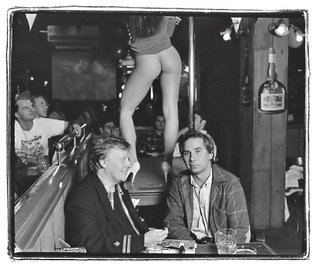
The language of drinking makes me think of some of the differences between the languages themselves. While it is one for the road in English in Spanish we say, "la del estribo," which includes the idea of finishing the last of your drink as you place your foot on the stirrup (estribo) of your horse. Let's have a drink usually means just that. In Argentina a "copetin" (a little wine glass) means a drink served with finger food. A beer in Mexico is a "cheve" which somehow chuzzes the sound of the z sounding c of cerveza.
A bar is a bar and only John Lekich would beg to differ as a good bar transcends all definitions. My friend Les Wiseman has risen to the occasion (on demand and with no lead time) to explain to us that perhaps a bar can even be a hotel room at the Holiday Inn on Howe Street before 9 am. Here is what he says:
Motorhead
Wiseman
AW-H mentioned in a phone call that he was blogging about drinking with celebrities. I immediately broke in and said you must mention the time with Motorhead and started rambling on the salient points of our lubricious intercourse with the kings of metal.
Scene: We walk into the hotel room and there are Lemmy and Philthy Phil. Lemmy with full wartage; Phil spiked and moustachioed. As we go to shake hands, we notice that our shoes are splopping through the carpet. What the hell happened here? Lemmy says, “Oh, an ice bucket got overturned and we never bothered to clean it up.” Must have been a heck of an ice bucket, about six square feet was underwater. Then Lem cracks a quart of Smirnoff and puts a couple fingers of orange juice in some tall tumblers and fills the rest with vodka. Throughout the interview, Lem keeps topping up the drinks, though the orange juice is never touched again until we are pulling on about eight inches of relatively clear fluid. I mention that it seems a touch early in the day of the gig to be hitting it with such enthusiasm. Phil pipes up, “We’re alcoholics, this is nothing for us.”
When we are joined by Robbo Robertson, the former Thin Lizzy guitarist who was replacing the departed Fast Eddie Clarke on the Another Perfect Day tour, he was completely out of sync with the black clothing and facial hair of Lem and Phil. He was also noticeably suffering the effects of the previous night, to which the others were conditioned and showed no such effects.
I asked what sort of groupies Motorhead got. Lem opened the door to an adjoining room and called for a young lady to come in. She was rail thin and stringy haired, mumbling incoherently. Lem nodded his head to her. “She’s from Philadelphia. She has no idea what city she’s in or where we are.” Then he motioned for her to remove herself and she shuffled back into the room and closed the door.
Robbo held his head and said nothing. Lem was effusive. Going on about amphetamine sulfate, his Canadian bust, and was egged on by Phil to talk about the fact that his father was a preacher and hence his longstanding dislike of organized religion. Phil pulled out a picture of his girlfriend, showed it to me. She was an ethereal type with a resemblance to Kate Bush. Not the brassy metalhead babe one might assume. Phil got a bit maudlin about being away from her.
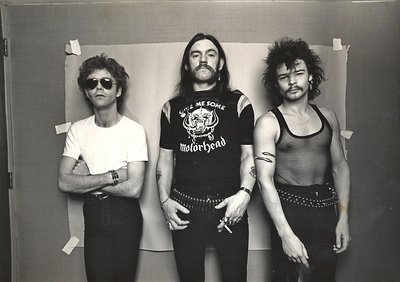
Time for A W-H to take the shot. The guys were great, though the black and whites likely do not show Robertson’s somewhat greenish hue. After the shoot, we all waddled off and it was only on trying to sight myself through the door that I realized maintaining my verticality might be a touch of a challenge for the next few hours.
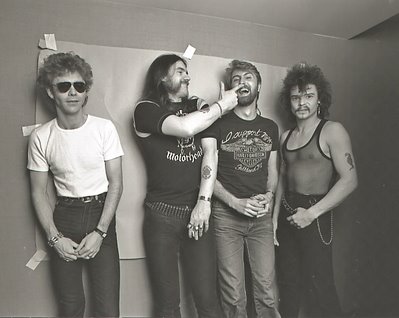
That night, the show at the Kerrisdale Arena was awesomely loud. The best acoustics were to be had at the MacDonalds a block away. Inside, the volume of air displaced by the speakers was large enough to press my clothing to my body. The band was tight and showed no deleterious effects from the breakfast libations. The only downside of the show was that, just before it began, news circulated that the greatest of rock crits, Lester Bangs had been found dead in his apartment. July 15, 1981.
L.M. Gottschalk & The Dutch Tilt
Thursday, June 14, 2007
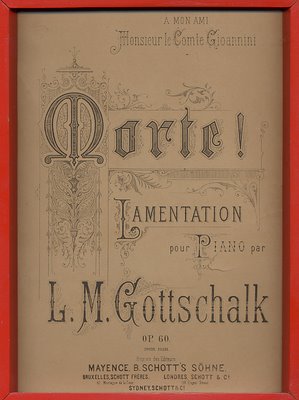
I have written a bit about American composer and piano virtuoso L.M. Gottschalk here and also about my mother's great aunt Buenaventura Galvez Puig. Pianists and piano composers are in my mind these days as I make it a point to put a CD of piano music in the car when I pick up Rebecca on Mondays to take her to her piano lessons. She always wants to know who is playing or the name of the composer. Of late we have been listening to Philip Glass playing his piano sonatas and Erik Satie. I am itching to buy some Gottschalk so she can make the connection through my grandmother Lolita (seen here at left with her aunt Buenaventura, right) to the piano playing heritage of my family.
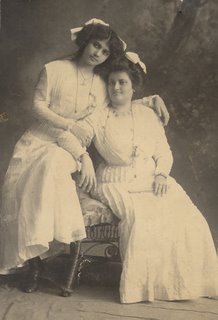
It was Buenaventura who must have given my mother her first piano lessons. This connection through Lolita is one that will fascinate Rebecca as she knows a lot about her even to my grandmother's fondness for dunking bread smeared with butter, peanut butter and jam in her café con leche.
Today I thought of another angle on L. M. Gottschalk. It is with an American born photographer, James La Bounty who has lived in Vancouver a few more years than my 30. I remember the first time I ever met him (27 years ago) at a Vancouver Magazine monthly contributors' party (we called them piss-ups). I was only then getting started as a magazine photographer and both James La Bounty and Howard Fry were nicely established. The former as an editorial photographer and the latter as a fashion photographer. I asked La Bounty what his home town of San Francisco was like. From his 6ft 4 inch vantage point he looked down on me and with a perfectly modulated FM radio voice he told me, "It's much like Vancouver except the streets go up and down and they have cable cars." He then turned around and moved away. It wasn't too long after that incident that my star began to rise in Vancouver Magazine as his began to decline. But La Bounty always got the lucrative annual reports and the travel assignments I rarely got. In my thirty years in Vancouver I have seen many photographers come and go. Some have stayed. But the only photographer who had and has a style all his own, a style I don't always understand but always admire, is La Bounty. If I ever felt that I had to compete for work by doing my best I have always had La Bounty in my mind.
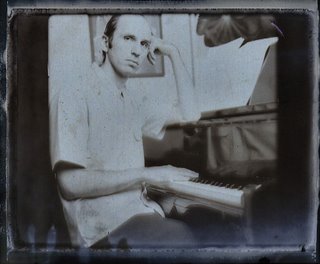
La Bounty was also first in photographic approaches that we adopted only later. He was the first to tilt the horizon (Dutch Tilt). He was also the first to state that he did not shoot straight portraits as his were conceptual portraits. I thought at the time that he was a bit too lofty in conceit to call his style that. I would now not think twice about stating that I shoot conceptual photographs.
If La Bounty didn't completely push me aside with his superior photographic talent it was in that he had a "tragic" flaw. This tragic flaw is only as I see it. I am sure he sees it differently. I have always thought myself an efficient commercial photographer, no more and no less. La Bounty had three facets. He was a commercial photographer, an art photographer and a composer pianist. My theory is that he channeled his energies three ways.
In my 30 plus years in Vancouver La Bounty is the only person who not only knew who Gottschalk was but also knew he had been born in New Orleans an that those two first initials stood for Louis Moreau.
As for Morte! the legend is that it was the last music Gottschalk (who was terminally ill) played at a concert in Rio de Janeiro on November 25, 1869. Actually it was the last complete work he ever played as he had begun his Tremolo when he had to stop.
Wednesday, June 13, 2007
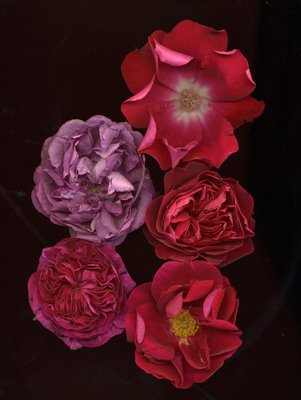
It was a Saturday sometime in 1957 when as a boarder at St. Edward's High School I went on my usual trip downtown (they let us go on Saturdays and Sundays). I did my usual round of the bookstores on 6th Street. There was no music then, only bookstores that sold Frank Yerby, Frank G. Slaughter, and science fiction paperbacks, barber college and the danger that some spics might roll you if you looked too white. With my crisply starched and ironed khaki pants, my spit-shined long pointed black shoes and my freshly combed duck cut (I used Top Brass that came in a bright red tube) I was safe. From there I would go to the record store on Congress Avenue not far from the Austin movie theater and the Stephen F. Austin Hotel where I often had my favourite cherry-vanilla ice cream with bits of red cherries. At the record store I distinctly remember seeing the album cover The Dave Brubeck Quartet - Jazz Red Hot and Cool.This has to be one of the most appealing record albums ever made. I was not sophisticated enough to note that the photo (taken at the Basin Street Night Club in New York) was credited to Richard Avedon. But somehow I noted the explanation that the model was wearing Jazz Red Hot and Cool lipstick by Revlon!
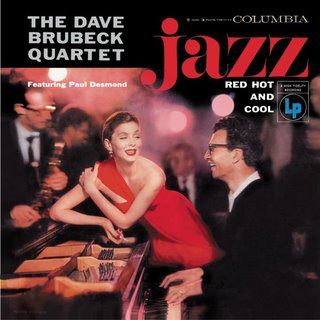
This is perhaps my favourite quiet Dave Brubeck with the exquisite The Duke. It also features Indiana a tune I played on my alto saxophone with the St Ed's band at basketball and football games. Our school had Brothers of the Holy Cross, so many of our boarders came from Indiana as they hoped to get good grades and then be accepted by the University of Notre Dame in Indiana that also had Brothers of the Holy Cross. For me Indiana awakens a nostalgia for sports that were really amateur, cheerleaders in bobby socks with a glimpse of panty here and there. Being cooped up at a boarding school for seven days (the only woman in sight was the black cook) had its pressures.
The above is all to explain that I learned to be partial to red thanks to that Avedon record cover and that recently I have become most interested in my red roses and even those that are purplish red. I am fascinated how some of these red roses fade with age to beautiful purples that shift to magenta, lilac and in some cases to a bluish tint with metallic overtones. The roses that do this are ancient Gallicas, moss roses and the like. The modern red hybrid tea roses don't do this. This is one more reason why I have none of them in my garden. All the roses, but one, featured in today's scan (but scanned last night) have intense scent. One of them is a modern "ancient" Gallica.
Top right: Rosa 'Dortmund', Kordes Germany 1955. This is a vigorous single climber with thorny branches but alas has no scent.
Middle left: Rosa 'William Lobb', Laffay France 1855. William Lobb is is a moss rose with lots of scent. The large flowers are a mixture of purple, grey, magenta and pink, slightly paler on the reverse.
Middle right: Rosa 'L.D. Braithwaite, Austin UK 1988. This English Rose is a cross between The Squire and Mary Rose. The colour is described by Peter Beales as being, "...rich glowing crimson with a hint of cerise." It has lots of perfume.
Bottom left: Rosa 'Charles de Mills' This is a rose of uncertain origin. It blooms only once (like the moss rose above) but it has intense perfume and a bloom that is flat that looks like someone sliced with a razor. Nobody knows who Charles de Mills was.
Bottom right: Rosa 'James Mason', Beales UK 1982. This rose is an anachronism as it is an ancient Gallica that was bred recently in honour of an actor who also happened to be a rosarian. The single bloom is scented. James Mason is not remontant.
Charles de Mills
Dave Brubeck
L.D. Braithwaite
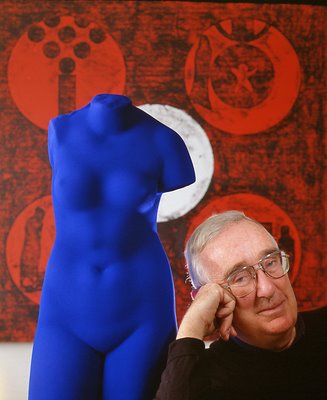
I first met architect Ian Davidson around 1985 and I photographed him in Yaletown in relation to a project he was involved which was 7 story office building his firm, Davidson & Johnston was going to build. It was to be the beginning of a the Yaletown we now know. I took the shot where Mainland ends at Davie. At the time the old Connaught bridge (the one that had wood instead of pavement in the middle) was being replaced by what we now call the Cambie Street Bridge.

Yaletown, then, was surrounded by nothing and all those condos on Pacific Boulevard were yet to come. But some construction had begun in preparation for Expo 86. Two or three years later I found out that Davidson was a serious art collector. He was also a member of the board of the Vancouver Art Gallery. There are many who have said that Davidson and his pal Monty Clark of the Monty Clark Gallery could and yet can decide who sells well in Vancouver, who is a serious artist and who is not.
In Davidson's apartment I was attracted by this Yves Klein torso. The intensity of the blue was dazzling. Davidson told me that Klein had patented it and called it International Klein Blue. I remember taking at least 35 slides trying to decide where to place Davidson in relation to the red painting behind him. I had second thoughts of the almost white space at the bottom left. When I raised my camera the white disappeared but something else bothered me. In the end I settled for this angle and I obtained many variations. But this one I like as Davidson's almost smile contrasts with the cool blue. It's one of my favourite portraits but few have ever seen it.

When my mother traveled to Mexico from Argentina in 1952 she was given there a red rebozo. Its intense, rich red reminded me of the robe from that first Cinemascope production The Robe with Richard Burton and Jean Simmons. The robe was the robe of Jesus Christ. My mother's rebozo was made of rough cotton (I believe) and the red came from a natural vegetable dye. I have treasured it all these years adn I ofen used it as a portrait prop.

When I met Jennifer Froese, a friend of Bif Naked, she seemed very sad. She was the very opposite of her friend. When she posed for me this sadness was evident but wonderful at the same time. She revelead her tattoo and here you see but a glimpse of it and of my mother's red Mexican rebozo.

It was a Saturday sometime in 1957 when as a boarder at St. Edward's High School I went on my usual trip downtown (they let us go on Saturdays and Sundays). I did my usual round of the bookstores on 6th Street. There was no music then, only bookstores that sold Frank Yerby, Frank G. Slaughter, and science fiction paperbacks, barber college and the danger that some spics might roll you if you looked too white. With my crisply starched and ironed khaki pants, my spit-shined long pointed black shoes and my freshly combed duck cut (I used Top Brass that came in a bright red tube) I was safe. From there I would go to the record store on Congress Avenue not far from the Austin movie theater and the Stephen F. Austin Hotel where I often had my favourite cherry-vanilla ice cream with bits of red cherries. At the record store I distinctly remember seeing the album cover The Dave Brubeck Quartet - Jazz Red Hot and Cool.This has to be one of the most appealing record albums ever made. I was not sophisticated enough to note that the photo (taken at the Basin Street Night Club in New York) was credited to Richard Avedon. But somehow I noted the explanation that the model was wearing Jazz Red Hot and Cool lipstick by Revlon!

This is perhaps my favourite quiet Dave Brubeck with the exquisite The Duke. It also features Indiana a tune I played on my alto saxophone with the St Ed's band at basketball and football games. Our school had Brothers of the Holy Cross, so many of our boarders came from Indiana as they hoped to get good grades and then be accepted by the University of Notre Dame in Indiana that also had Brothers of the Holy Cross. For me Indiana awakens a nostalgia for sports that were really amateur, cheerleaders in bobby socks with a glimpse of panty here and there. Being cooped up at a boarding school for seven days (the only woman in sight was the black cook) had its pressures.
The above is all to explain that I learned to be partial to red thanks to that Avedon record cover and that recently I have become most interested in my red roses and even those that are purplish red. I am fascinated how some of these red roses fade with age to beautiful purples that shift to magenta, lilac and in some cases to a bluish tint with metallic overtones. The roses that do this are ancient Gallicas, moss roses and the like. The modern red hybrid tea roses don't do this. This is one more reason why I have none of them in my garden. All the roses, but one, featured in today's scan (but scanned last night) have intense scent. One of them is a modern "ancient" Gallica.
Top right: Rosa 'Dortmund', Kordes Germany 1955. This is a vigorous single climber with thorny branches but alas has no scent.
Middle left: Rosa 'William Lobb', Laffay France 1855. William Lobb is is a moss rose with lots of scent. The large flowers are a mixture of purple, grey, magenta and pink, slightly paler on the reverse.
Middle right: Rosa 'L.D. Braithwaite, Austin UK 1988. This English Rose is a cross between The Squire and Mary Rose. The colour is described by Peter Beales as being, "...rich glowing crimson with a hint of cerise." It has lots of perfume.
Bottom left: Rosa 'Charles de Mills' This is a rose of uncertain origin. It blooms only once (like the moss rose above) but it has intense perfume and a bloom that is flat that looks like someone sliced with a razor. Nobody knows who Charles de Mills was.
Bottom right: Rosa 'James Mason', Beales UK 1982. This rose is an anachronism as it is an ancient Gallica that was bred recently in honour of an actor who also happened to be a rosarian. The single bloom is scented. James Mason is not remontant.
Charles de Mills
Dave Brubeck
L.D. Braithwaite
Ian Davidson's Yves Klein
Monday, June 11, 2007

I first met architect Ian Davidson around 1985 and I photographed him in Yaletown in relation to a project he was involved which was 7 story office building his firm, Davidson & Johnston was going to build. It was to be the beginning of a the Yaletown we now know. I took the shot where Mainland ends at Davie. At the time the old Connaught bridge (the one that had wood instead of pavement in the middle) was being replaced by what we now call the Cambie Street Bridge.

Yaletown, then, was surrounded by nothing and all those condos on Pacific Boulevard were yet to come. But some construction had begun in preparation for Expo 86. Two or three years later I found out that Davidson was a serious art collector. He was also a member of the board of the Vancouver Art Gallery. There are many who have said that Davidson and his pal Monty Clark of the Monty Clark Gallery could and yet can decide who sells well in Vancouver, who is a serious artist and who is not.
In Davidson's apartment I was attracted by this Yves Klein torso. The intensity of the blue was dazzling. Davidson told me that Klein had patented it and called it International Klein Blue. I remember taking at least 35 slides trying to decide where to place Davidson in relation to the red painting behind him. I had second thoughts of the almost white space at the bottom left. When I raised my camera the white disappeared but something else bothered me. In the end I settled for this angle and I obtained many variations. But this one I like as Davidson's almost smile contrasts with the cool blue. It's one of my favourite portraits but few have ever seen it.
Jennifer Froese's & My Mother's Red Rebozo

When my mother traveled to Mexico from Argentina in 1952 she was given there a red rebozo. Its intense, rich red reminded me of the robe from that first Cinemascope production The Robe with Richard Burton and Jean Simmons. The robe was the robe of Jesus Christ. My mother's rebozo was made of rough cotton (I believe) and the red came from a natural vegetable dye. I have treasured it all these years adn I ofen used it as a portrait prop.

When I met Jennifer Froese, a friend of Bif Naked, she seemed very sad. She was the very opposite of her friend. When she posed for me this sadness was evident but wonderful at the same time. She revelead her tattoo and here you see but a glimpse of it and of my mother's red Mexican rebozo.
Sunday, June 10, 2007
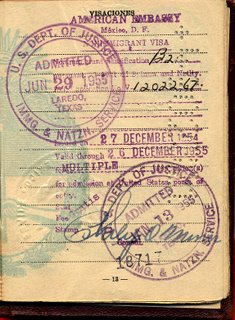
The houses were detached with large front lawns. Children were playing. There were no fences or walls between the houses. As a young boy living in Mexico, bardas and paredones (walls and big walls) were the rule. I had never seen anything like this. I saw red Flyer wagons and strange bicycles with thick tires. I am not sure if subsequent exposure to the Saturday Evening Post confused my memory. I am almost sure I saw a Dalmatian and a Cocker Spaniel running with the kids. This was Laredo, Texas, June 29, 1955 and I was 12 years old. My mother bought me a Revell plastic kit of what was a circa mid 50s Chevrolet truck. I was in heaven. It was my first venture into the United States of America. I have been an Ameriphile since. I had yet to note the significance that this first venture was through Texas.
This first entry into the United States was the realization of a dream that had started in Buenos Aires through my mother's connection to Americans by virtue of her job at the local American Grammar and High School. We were lower middle class but as her son I had free tuition so I attended the grammar school from kindergarden onwards. It was in that school where I made friends with Americans and first discovered Bazooka and Double Bubble, Gene Autrey and Roy Rodgers cap pistols and those impossible to get Lee jeans. We Argentines were starved and obsessed for American products. I remember with an absolute certainty a huge ad for Cemento Portland in the Retiro train station that had in parenthesis (USA) after every mention of the product. It would have seemed that Argentines and Perón depended on this great product to go forward on those Five-Year-Plans.
My mother brought stuff from school. I remember my first package of lime Jell-O, my first taste of a poppy seed bagel, and that Erector set that I received on Christmas made all my Argentine friends jealous.
I had a distorted view of my mythical country. I remember showing pictures to my friend Mario Hertzberg of wide-shouldered norteamaricanos who lived on a an island called Columbia. This island was protected by a very large statue of a woman holding a torch. This confused idea of mine had come (I realize this now) from an article in Life magazine about Columbia University ( its football team) and its proximity to the Statue of Liberty since the university is in New York City.
One of my mother's friends was the assistant (to the American Consul. The assistant and his wife would visit us in their baby blue 1950 Ford. When they parked this car at the front of my house I was the king of my Coghlan neighbourhood.
That first entry into the US through Laredo was one of several other short visits that my mother and I made. To get our Mexican residency (we had moved from Buenos Aires in 1954) we needed to leave Mexico and come back. This archaic and expensive bureacratic method still lives on in many countries.
While living in Nueva Rosita , Coahuila where my mother taught at the one room school house of the American Smelting and Refining Company school for the children of its engineers we made frequent visits to Eagle Pass (prounounced Eeglay Pass) by crossing from Piedras Negras, Coahuila. I remember most fondly the Eagle Pass Hotel that was decorated with Remington rifles and portraits of John Wayne. In Eagle Pass I sqandered $5.00 American Dollar bills (my special allowance) on Revell and Monogram plastic model kits. I had a huge collection.
These visits and my subsequent 4 years at St. Edward's High School in Austin, Texas managed to erase whatever ideas I had about being either an Argentine or a Mexican. I became an American. I became an American because I chose to be one. I felt American and even to this day I can claim that part of me is American. When you are in an American school and you study civics, you learn the workings of the three branches of the American federal government and even the details on the differences between misdemeanors and a felony it is difficult to "fight" the system.

It was difficult to fight this system when I visited the nearby Bergstrom US Air Force Base and ran my hands on the sharp edge of a Lockheed F-104 Starfighter or gazed up on the gigantic tail of a Boeing B-52 Stratofortress. It is only today that I notice or remember its name, The City of Austin.
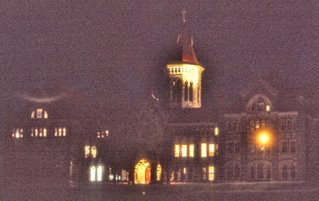
It was difficult not to feel American when I heard the F-101 Vodoos streak above our neo-Gothic main building knowing (so we had heard io on Radio KTCBC, now KLBJ!) that one of them had fired a rocket that had flown up the tailpipe of a Russian Mig in Korea and downed it in a flash.

It was difficult not to feel pride in being an American when I saw our Catholic White Hope, Senator Kennedy debate Vice-President Richard Nixon on TV.
On the Easter holidays of my first year at St. Ed's my mother had scraped up enough money to send me on a school-sponsored trip (we went in a rented Grehound Scenicruiser!) to Washington, DC.
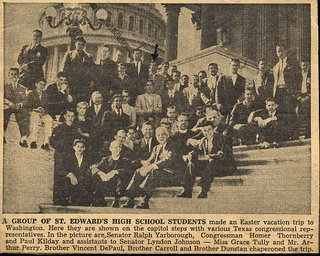
I have memory of shaking hands with a tall man with large hands and large ears. He gave me a card which I promptly threw away. It was a card that certified that I (my name was written on it) I had attended a hearing at the US Senate Chamber. It was signed by our Texas senator, Lyndon Johnson. The B of the LBJ was not to surface until John Kennedy became JFK. It was in DC where I bought my first serious camera, and Agfa Silette type 1 at a pawnshop. I asked for film and I remember that the druggist said, "Try Kodak Tri-X, it's the best film we carry." To this day, even though they have stopped the manufacture of many of my favourites, i shoot the film in from those familiar bright yellow and blue boxes.
Looking back on this all as Rosemary and I prepare our July 15 trip with Rebecca to Mérida, Yucatán via Austin, Texas I can feel that this American part of me is a bit less American and lot more Texan. It was living and growing up in Texas, falling for my first sweatheart Judy Reyes that was so important in my becoming who I am today. Those long bus trips from Nueva Rosita to Austin, took me on Continental Trailways Flxible buses that passed through Texas towns like Carrizo Springs, Del Rio, Uvalde, Crystal City (the first US city with an elected official of Mexican heritage) on its way to San Antonio. There I would board one of those exceedingly handsome and magical Greyhound Scenicruisers that seemed to fly on the Texas concrete-made expressways (as Texans call freeways) which were part of President DwightD. Eisenhower's legacy to the US. These expressways started the American dependancy on the automobile. I remember that both Bing Crosby and Bob Hope appeared in large Life Magazine ads that trumpeted the advantages of concrete freeways.
Those lonely (it was always sad to leave home after the Christmas holidays to head to the bleak, cold and rainy Austin winters) bus trips were through stark Texas landscape of mesquite and desert with the occasional flash floods that made dry river beds suddenly look like small oceans. I first became used to that Texas landscape, and then without knowing I absorbed it so that I now anticipate with tremendous pleasure being able to see it soon.
Near Austin we will visit my friend Howard Houston and his wife Lynne. We will eat all kinds of Texas barbecue and Tex-Mex food. But principally we will visit our old St. Ed's and hug Brother Edwin Reggio CSC who was there with us and was a key element in our transition from boyhood into manhood.
But he had nothing to do with the fact that today I am a Canadian citizen born in Buenos Aires who feels very Texan. I feel Texan enough to know that the US has had two Texas born presidents. That second one, the one you probably cannot remember, was born in Denison, Texas. That's Dwight David Eisenhower.
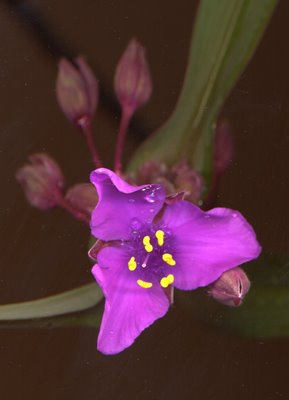
It was perhaps 6 or 7 years ago that I spotted a tall man with glasses at the Burrard door of the Vancouver Hotel. I went up to him and said, "How are you Dr. Vaughn? What are you doing in Vancouver?" He looked at me; thought about it and answered, "Hi, Alex I am here for botanical conference representing the US Department of Agriculture.My specialty is weeds."
In the late 70s and early 80s Kevin Vaughn was fascinated by hostas which are kind of the white mice of plants. Changes happen more quickly, they mutate with more frequency. Perhaps Vaughn saw in hostas a way of studying plants but in an accelerated more information could be obtained in less time. For his doctorate Vaughn wrote a treatise on the theory of how plants (and hostas in particular) variegate. He wrote these very important publications with K.G. Williams:
Chloroplast Mutants in Hosta
Genetics and Ultrastructure of a Dotted Leaf Pattern in Hosta.
An Ultrastructural Survey of Plastome Mutants of Hosta
From hosta Dr. Vaughn directed his research interest into Hemerocallis (daylillies).
Perhaps some 6 years ago I brought home some Tradescantia x andersoniana 'Concord Grape' for Rosemary. Tradescantias, named after John Tradescant, and English horticulturist and botanist have stems than when cut ooze a viscous secretion that hardens to form a silky web. This is why they are commonly called spiderworts.
Rosemary looked at my gift with doubt. Tradescantias remind me of the bird of prey space ships of Star Treck but Rosemary dislikes them because they flop over and look messy and the spent flowers (white in our garden)get rusty coloured.
Tradescantia x andersoniana 'Concord Grape' accurately named for the rich purple colour of their flowers surprised Rosemary by not flopping, blooming from late spring into fall and not only that, the spent blooms were tidy and beautiful.
Today I was surprised to discover that this plant is a Dr. Kevin Vaughn introduction. Some tradescantias are listed as weeds so perhaps in his research he decided to pass these on to us! Rosemary is grateful. And yet another plant in my garden has a human face behind it.
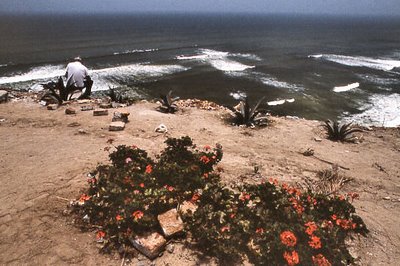
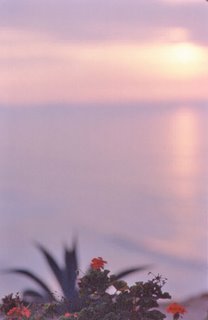
Since the 1950s I have eschewed air travel when Pan Am stewardesses handed out Juicy Fruit gum on Lockheed Super Constellations and metal detectors were used only for beachcombing. Now I prefer to get away in bed or by opening my kitchen door and venturing into my garden. Through association, just about every plant will take me elsewhere, often to another time and, more often than not, remind me of a person, too.
I have been giving thought to the above as my eldest daughter Ale is moving to Lillooet to live in July. "Papi, " she told me, "I bought the property up there so that you and Mami can get away." The trip each way is 4 hours and on a weekend, whatever relaxation we would enjoy it would be contrasted with the agony and stress of having to drive back on a Sunday on the Freeway 1 or the more dangerous Sea to Sky Highway. Rosemary is most upset and we wonder how many times we will go to visit. By the time Ale understands our philosophy of travel we will be perhaps long gone.
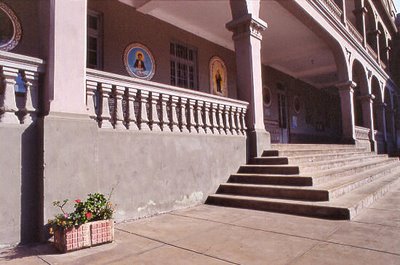
I remember as a child of 6 or 7 in Buenos Aires that I would go to our backyard "galpón" or shack were my father kept some old but very large wooden crates. In one I would place three bricks (gas pedal, brake, clutch), which I would lean on a thick board at my feet. Sitting on a smaller box in the middle of the crate and I would hold one of our dinner plates. It was my steering wheel. In seconds I was Juan Manuel Fangio, driving through the muddy roads of Argentina's interior.
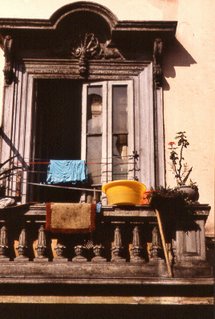
In the same way a plant propels me elsewhere. My Hosta 'Sieboldiana Elegans' whisks me to Japan. It was named for Philipp Franz Balthasar von Siebold, a German doctor who worked for Dutch traders on Dejima Island in Nagasaki harbour. Foreigners were not allowed on the mainland, so von Siebold would scour fodder sent to feed the livestock in hopes of finding unusual plants. That's where he saw his first hosta in 1823.
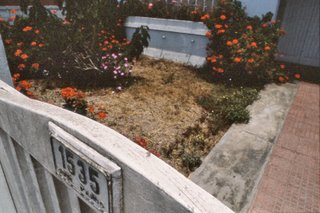
Another hosta, a bright yellow, green and white variegated Hosta 'Fortunei Albo Picta' beneath a white Camellia japonica , was named for Scottish plant hunter Robert Fortune. Because Camellia japonica is closely related to Camellia chinensis, the tea bush, it reminds me of Fortune's voyages in the Far East. In 1848 he traveled to China (dressed as a Chinese potentate and carried around in a litter) to spy on the cultivation of tea for the East India Company. Soon the British grew tea in India.
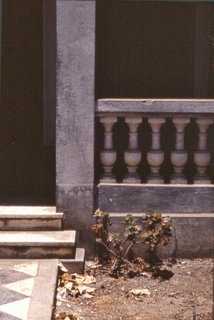
My Rosa 'Redouté'is an English Rose but it has ties to France. Redouté was the artist hired by Empress Josephine, an avid plant collector, to imortalize the roses in her famous garden at Malmaison. My thistles, Echinops ritro , and the taller thistle-like cardoon Cynara cardunculus , make me homesick for the Argentine pampa where I was raised. Charles Darwin describes the pampas in Voyage of the Beagle: There were immense beds of the thistle as well as of the cardoon: the whole country, indeed, may be called one great bed of these plants."
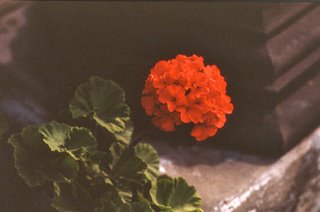
Sometimes I need only to travel to the kitchen, where a potted Pelargonium 'Vancouver Centennial' on the windowsill carries me away to Lima, Peru. In an interview with Peruvian novelist Mario Vargas Llosa in 1990, I asked him why his novels had frequent descriptions of potted pelargoniums (pelargoniums are commonly called geraniums but that is incorrect. While they are related, the true geranium, the crasnesbill geranium, is another plant altogether). Llosa explained that in 1499, Vasco da Gama brought the pelargonium from South Africa to Lisbon. It crossed to Exremadura in Spain. Then, whith Pizarro and Cortez, it sailed to the New World, finding a home in Lima's poor and sun-baked soil. "It thrives in adversity and neglect like our people," Llosa told me.
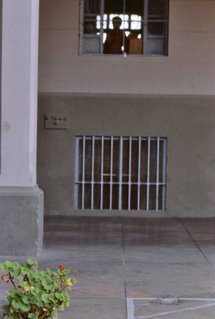
It is thanks to plant hunters, collectors and explorers that our gardens boast such botanical variety. We needn't suffer the vagaries of modern travel to experience the exotic world they explored. Now it is outside the kitchen door.
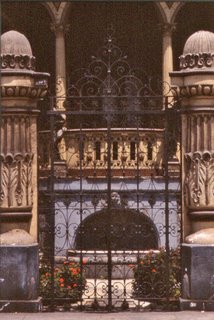
The photographs seen here are all pelargoniums (geraniums, if you will) in several areas of Lima, Peru.
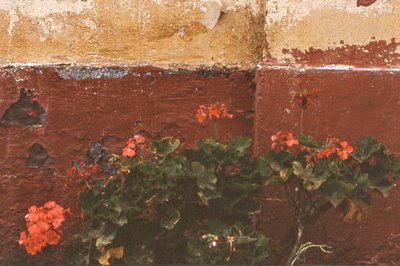
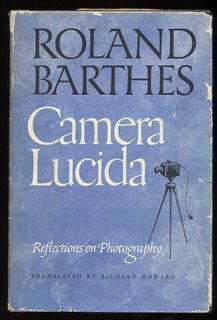
One day, quite some time ago, I happened on a photograph of Napoleon's younger brother, Jerome, taken in 1852. And I realized then, with an amazement I have not been able to lessen since: "I am looking at eyes that looked at the Emperor." Sometimes I would mention this amazement, but since no one seemed to share it, nor even understand it (life consists of these little touches of solitude), I forgot about it.
Chapter 1 - Camera Lucida - Reflections on Photography
Roland Barthes
Ever since I stared at Timothy O'Sullivan's photographs of American Civil War soldiers (and telling myself, "They were alive when these photographs were taken.") when I was around 9, I have been fascinated by photographs of long-dead people. I share and understand Roland Barthes's amazement.
Looking out of my window as I write this I can see the almost white (with a deep yellow centre) single blooms of Rosa 'Dupontii'. My first impression makes me smile as they remind me of the Cadbury chocolate Easter eggs that Rosemary used to buy for Ale and Hilary (I would steal a few and eat them with pleasure) when they were little girls and we lived in Burnaby. A secondary thought is that I am looking at a healthy light green shrub (quite tall at 9 ft) decorated with perfect fried eggs.
This vision does not quite agree with my memory that Dupontii has the scent of a ripe banana. That brings to mind the bananas, banana shaped chocolate covered soft candy that we Argentines love to eat when we go to the movies or the theatre. Those bananas are called bananas in Argentina even though in Mexico and in Spain bananas are plátanos. The white soft filling of the Argentine chocolates smell like Dupontii.
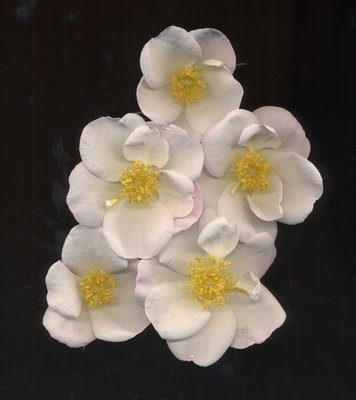
My grandmother had a fondness for what Americans call finger bananas. She called them plátanos dominicos and they were sometimes available in Mexico City. Abue would eat them with peanut butter and jam. In retrospect I would guess that they were called Dominican bananas after Dominican priests (the feared order of the Spanish Inquisition). The name was an irreverent opinion on the perceived size of their sexual organs.
It was not only my grandmother who enjoyed the jelly filled (much bigger than the local but equivalent dougnut holes) suspiros de monja (nuns'sighs) but also called bolas de monje (monk's balls) I loved them, too, dunked in café con leche.
Rosa 'Dupontii' at one time was considered a species rose so it was called Rosa dupontii. But recent research has indicated that this single rose (5 petals but sometimes with a couple more) is a cross between R. gallica and R. moschata. It was named for André Dupont, director of the Luxenburg Gardens in Paris. It is a safe guess that it was raised there, in about 1817.
With further research I found out that Dupont was also a gardener at Empress Josephine's (Marie-Joseph-Rose-Tascher de la Pagerie) rose garden (over 250 varieties) at Malmaison.
Alas I cannot make a direct connection between Napoleon and my Rosa 'Dupontii' as the rose came into existence two years after Waterloo (1815). But of course the non connection is a connection nonetheless. Dupontii not only makes me think of Cadbury chocolate eggs, fried eggs, bananas, small bananas but now also of the Emperor himself. After all if Josephine gazed upon both the Emperor and at Dupontii then the connection is there.
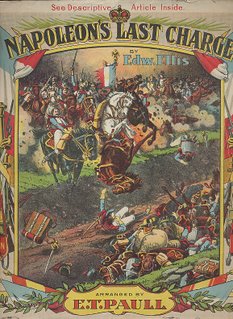
Rosemary came back last week from visiting her sister in New Dublin, Ontario. She brought back her old piano sheet music that she is going to have Rebecca play. One of the sheets caught my eye.
Napoleon
Napoleon in Egypt
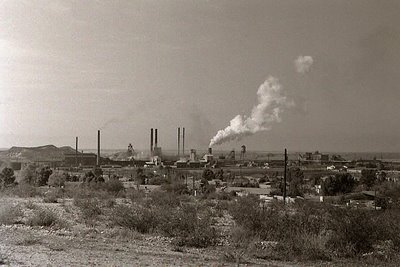
Coke is a solid carbonaceous material derived from destructive distillation of low-ash, low-sulfur bituminous coal. The volatile constituents of the coal, including water, coal-gas and coal-tar, are driven off by baking in an airless oven at temperatures as high as 1,000 degrees Celsius so that the fixed carbon and residual ash are fused together.
Making coke, at least back in the mid 50s was a polluting endeavour but I never gave it much thought. In the mid 50s I lived with my mother in Nueva Rosita, Coahuila, a mining town where ASARCO (American Smelting & Refining Company) called the shots. I remember the first day I ever saw Nueva Rosita. We had landed, the day before in a DC-3 in a desolate airport (an airport because it had a dirt landing field that happened to have a shack with a revolving sock on the roof). This was Monclova, Coahuila which was the centre of the Mexican steel industry run principally by a company called Altos Hornos (high ovens). From Monclova we took a bus to Nueva Rosita. We arrived in the middle of the night but I remember seeing some lights and smoke that glowed in the dark cloudless sky. This was a high desert and I soon found out it rarely rained. When I woke up the next morning it was already around 38 degrees and I was bathed in sweat. I got up and looked out of the window. What I saw is what you see here even though I took this ancient Ektachrome and the b+w negative about three years later.

My mother explained that in Nueva Rosita they mined zinc and made coke. I never did ask what coke was but soon after I found out that coal was burned in an almost oxygen free oven and the coal was converted into a porous substance wich was used to make steel. I never did make the connection that our Nueva Rosita coke helped industrialize Mexico by contributing to the steel production of Monclova.
It is only yesterday that I made the complete connection thanks to an English Rose, Abraham Darby, that has begun to bloom in my garden. This 1985 introduction by David Austin does not smell of myrrh like so many of my roses. It has an intense perfume of fruit and old roses. I should have obtained this lovely rose a long time ago. I finally did.
I looked up Abraham Darby (1678-1717). It seems that by the end of the 17th century England was running out of forests to cut down to make the charcoal that was then used to smelt iron. It was around 1709 that Darby successfully used coke as fuel to smelt iron at his ironworks in Coalbrookdale in Shropshire. England had plenty of coal, from which coke was made.

Darby's process helped usher in England's industrial revolution. Darby's grandson, Abraham Darby III (1750 - 1791) constructed the world's first iron bridge, over the Severn river at Coalbrookdale, Shropshire in 1779.
When I crossed the iron bridge in Shropshire I did not give it much thought nor did I stop at David Austin's rose nursery. This was 1987. I might have run into Rosa 'Abraham Darby' at Austin's nursery. But I didn't know much about roses then. I wasn't even interested in them.
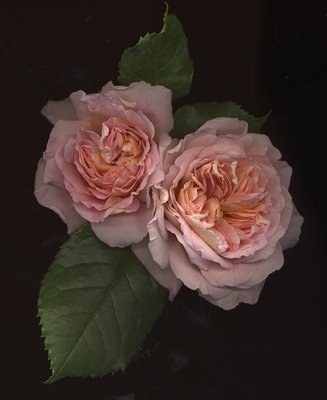
Last night when I brought in a couple of my Abraham Darby blooms, the intense perfume cleared my mind like Keen's Mustard and Nueva Rosita (small new rose), coke, iron, steel, the old iron bridge I had crossed back then, and David Austin's rose all came together and made a lot of sense. Pity my mother is not around. "You know mother, there is this rose and........"

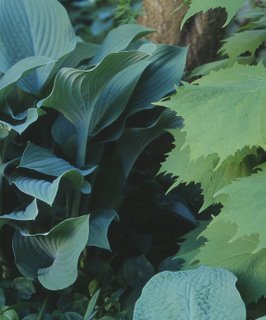
A few days ago in the late evening (8pm) I took some pictures of my emerging garden. It is in the waning days of May that hostas look their crisp best. The nicest feature of the hostas in these photographs is that most of them are ordinary hostas except for my prima donna Hosta 'June' that demands I photograph her whenever I look in her direction. She is always perfect and her perfection does not fade until September when most of my other hostas and perennials show the wear and tear of spent blooms, bug and slug damage and are ready to call it a year.
Top left you see Hosta 'Krossa Regal' with Kirengeshoma palmata . Right is Hosta 'June' with Osmunda regalis (Royal Fern) to her right. Behind left is Hosta 'Gold Regal', not quite gold/yellow yet as the colouring happens in July. To June's right is an extremely ordinary and old hosta, so old that it is difficult to now get her in the local garden trade.

She is Hosta 'Antioch'. She measures five feet across and you can see more of her, left. Behind Osmunda regalis is the cinnamon fern, Osmunda cinnamomea.
Sometimes it pays to play with a new camera that is not too familiar. The last picture seen here measures 4 inches across in its original size. The pictures taken by my German swivel lens panoramic, the Noblex 175 should be 7 inches across. I was ready to see Horst until I figured out that I had loaded the Noblex incorrectly.


Many know exactly where they were and what they were doing the day that US President, John F. Kennedy was assasinated in Dallas. I know exactly where I was and what I was doing but I also know the coordinates for another important moment in our history. On July 20, 1969 at 10:17:42 (actually 9:17:42 as Mexico City did not have daylight saving time) when Neil Armstrong stepped on the moon, I shut off our TV in our Mexico City apartment and told Rosemary we were going to the movies.
When I photographed actor Cliff Robertson in Whistler, BC sometime in the late 80s I told him about my experience in seeing him play Charly in the 1969 Ralph Nelson film by of same name. I had read in 1964, Daniel Keyes's 1960 novel Flowers for Algernon (extended to novel form from his earlier novella) from which Charly's screen play was based on. Charly, the story of a retarded man who is chemically made intelligent but regresses back to his earlier state, while being lovingly cared for by Claire Bloom was a film I was not going to miss back in 1969. I had been married to Rosemary for a year but I still remembered one of my first girlfriends (1964) Judy Brown who looked like Claire Bloom. I simply saw all Claire Bloom films and still do. Besides I was a sucker for this sort of film as I then enjoyed Terence Stamp (who wakes from a coma after 30 years)in The Mind of Mr Soames. In this film Terence Stamp starts as a fully grown baby who very quickly learns to be an adult.
Because of the moon landing, Cine Polanco, where Rosemary and I saw Charly, was virtually empty. It made the tragic movie all that more poignant for us. I remember leaving the empty movie house completely drained with no memory of the event of the day that was unique to the human race. From that day on we could uniquivically think, "We (from the vantage point of the moon) are from there (pointing at the blue circle looming over the moon's horizon)!
There was one aspect of the film that would come to haunt me and almost offend me years later when around 1976 while watching TV in Vancouver I saw a commercial seeking money to research dyslexia. I was a dyslexic and I had never known. The Charly posters and the title of the film had that r reversed. It now almost offends me as much as Toys Я Us.
In 1970 we institutionalized my grandmdmother Lolita who progressively took baths and got ready for bed earlier and earlier during the day. One day she came back from seeing her son Tony (my Uncle Tony) in Egypt and she did not recognize who we were. This was my introduction to Alzheimer's. Since then I have known several close friends who have had to face this disease in their family.
On a purly objective look at Alzheimer's (ignoring the suffering of those who must live with family members who increasingly become violent) I find it an almost reversely symmetrical fading out of our existence that parallels our gradual fading into memory from birth. I remember being 6 but not before.
When Rebecca was 5 and we took her to Washington DC to the American Hosta Society National Convention she played the a game of naming (in rapid succession) hostas connected to women with a woman who sported a convention tag on a DC Rapid Transit car. She fired off, Hosta 'Marilyn', Janet, Mildred Seaver, June and on. I was dazzled but I kept telling Rosemary, "If we were to die today, Rebecca would not rmember us at all."
I have been noting with interest( Why did I not note this with my two daughter's?) how Rebecca's memory seems to work. She has an excellent memory but the names of plants she knew well three years ago I must now reinforce as she has forgotten. Her mental process seems to mimic that terrible computer process by which sometimes when you write emails or in Word, and when you go back to correct mistakes, the insertion of the correction removes (gobbles up) the letters after it. A similar situation would be the running of a locomotive on a few set of tracks in which the forward path would be laid with tracks from ground covered that far.
Yesterday I went to Rebecca's and we mixed alfalfa meal with magnesium sulphate (epson salts) and watered her roses (Rosa 'Mary Magdalene', Tuscany Superb, Mrs. Oakley Fisher, The Fairy and Popcorn ). We removed all the dead wood and leaves that had black spot. It was then that I was startled by a request.
"Papi, I really want Königin von Dänemark." Now Queen of Denmark is a brand new rose (an 1826 Alba) in my garden and it has yet to bloom. Twice in the last few weeks Rebecca has asked me to show her the rose bush as I had yet to find a spot for it. And when I did Rebecca did not know where it was. This rose has sparked her not quite fading interest in roses. I will have to buy her one.
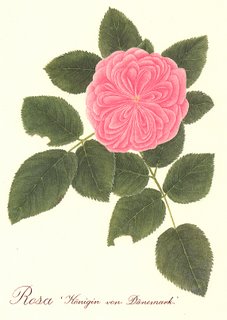
Charly, Mr. Soames, Rebecca: It is fascinating to watch the building up of memory so close at hand.
Addendum: Cliff Robertson's overall green/cyan cast is due to the colour negative's deterioration from the mid 80s. If I were to remove the green/cyan cast from the picture, Robertson's face would warm up beyond reality. This is an example of a photograph that can only be "improved" with extensive Photoshop restoration which is presently beyond my scope of expertise.

To anybody who might be a faithful reader of this, and if you don't have a passing interest in roses, you may have to search for something else to while away the next few summer days. I am convinced that my relationship to roses helps me understand the world and the people I interact with. I am convinced that roses reveal to me my many flaws but at the same time they (the roses) gently offer corrections that just might make my relationship with others a bit better.
To continue on this subject of being a plant snob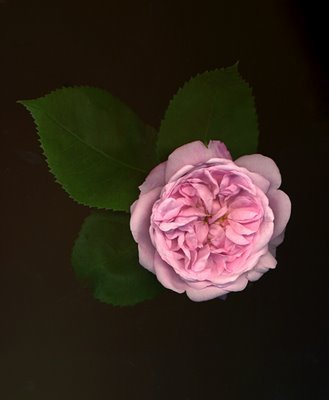 I must state that while I am dead serious there is also a bit of whimsical lightness in it. Take for example the three roses featured today. Of the first, the little five-petalled single, the species rose Rosa glauca Roger Phillips and Martyn Rix in their Random House Guide to Roses write:
I must state that while I am dead serious there is also a bit of whimsical lightness in it. Take for example the three roses featured today. Of the first, the little five-petalled single, the species rose Rosa glauca Roger Phillips and Martyn Rix in their Random House Guide to Roses write:
Rosa glauca , Pourret ( R. rubrifolia Vill) A tall shrub up to 4 m with support but usually with arching branches and few thorns, easily recognized by its very grey or sometimes purplish leaves, and small deep pink flowers. Hips brownish red. Native of the mountains of Central Europe, from the Pyrenees and Alps eastwards to Poland, Romania and Albania, but not common. Introduced into cultivation in England before 1830, this rose has recently become excessively popular for its foliage, both in a garden setting and for use in flower arrangements. Beautiful specimen bushes grow on the terrace of Crathes Castle in Aberdeen.
Seen with Rosa glauca in my scan is David Austin's English Rose, Rosa 'St Swithun'. The highly scented (of myrrh) blooms are 4½ inches wide and my bush blooms most of the summer. The third rose is a classic rose, Rosa 'Fantin Latour'of which little is known. Peter Beales writes in his Classic Roses :
A superb mystery rose with records conspicuously absent. The soft delicate pink flowers and their form place them here (Centifolias[Provence Roses, Cabbage Roses] -Forms and Hybrids), although its foliage is smoother, darker green and more rounded than is typical. Its shoots too are less thorny. I find the all-pervading perfume rather more Alba-like than Centifolia. One theory of its origin suggests that it was once used as an understock, but since it does not root readily from cuttings, at least for me, I think this unlikely.
From the point of beeing a practical gardener one would say that the best rose here is Rosa 'St Swithun' as it has very large, beautiful and extremely fragrant blooms which occur from June to fall. Rosa glauca blooms only once and the flowers are only lightly scented and quite small. Fantin Latour flowers are 3 inches wide, they are scented but they appear only once in early June and that's it for the season.
Some snobs (and I know a few of these) keep their Rosa glaucas pruned severely (they get almost no flowers) but the foliage of these specimen plants is fresh and the leaves develop that prized and snobbish glaucous green. I would like to add that that Rosa glauca immediately develops hips (right after the blooms) that are the colour of Hershey milk chocolate!
The scans you see here are all from flowers I cut today from plants in my garden. This snob has chosen to have all three for different reasons. I have been rewarded in my choice democracy by discovering (after a 7 year wait) that Rosa 'Fantin Latour' when allowed to grow to about 7 ft will become extremely shade tolerant. In my garden where I have a heavy tree canopy this is a definite plus. And this is true even if a true plant snob would point out that Fantin Latour's leaves are a bit too big in proportion to the size of bloom.
Rosa glauca appeals to my Rosemary who may be more of a snob (or at least in the direction of plants that may have blue in them and are not immediately showy) than I am. We have to very large specimens which never show any disease.
Now St Swithun is special for me because it was the last rose Rosemary ever showed a keen interest in. She lost this interest, outwardly at least, as soon as I became enamoured with roses. Some 7 years back Rosemary spotted St Swithun at the VanDusen Garden Show and she told me she had to have it. It was a display plant at a nursery booth so she went early on the last day and put a hold on it. We brought him home and it rained for a week. It rained so much that it made the news.
I investigated the story behind St Swithun and this is what I found out. St Swithun is apparently the saint to blame for rainy summers. It is said that if it rains on his special day, 15 July, it will then rain for forty days after that.
It all began when he was made Bishop of Winchester in 852 by King Ethelwulf of Wessex. Winchester was the capital of Wessex, and during the 10 years Swithun was there, Wessex became the most important kingdom of England.
During his life, instead of washing out people's summer holidays, and damping down their spirits, Swithun seems to have done a lot of good. He was famous for his charitable gifts and for his energy in getting churches built. When he was dying in 862, he asked that he be buried in the cemetery of the Old Minster, just outside the west door.
If he had been left there in peace, who knows how many rainy summers the English may have been spared over the last 1000 years. But, no, it was decided to move Swithun. By now, the 960s, Winchester had become the first monastic cathedral chapter in England, and the newly installed monks wanted Swithun in the cathedral with them. So finally, on 15 July 971, his bones were dug up and Swithun was translated into the cathedral.
That same day many people claimed to have had miraculous cures. Certainly everyone got wet, for the heavens opened. The unusually heavy rain that day, and on the days following, was attributed to the power of St Swithun.
Swithun was moved again in 1093, into the new Winchester cathedral. His shrine was a popular place of pilgrimage throughout the middle ages. The shrine was destroyed during the Reformation, and restored in 1962.
It would seem that being able to have all three roses in my garden would represent a botanical version of learning to live with one's friends. If being a plant snob creates this situation then we should all grow Rosa glauca and when visitors come to your garden, like Rosemary you would say, "The flowers are insignificant but isn't the foliage lovely?"
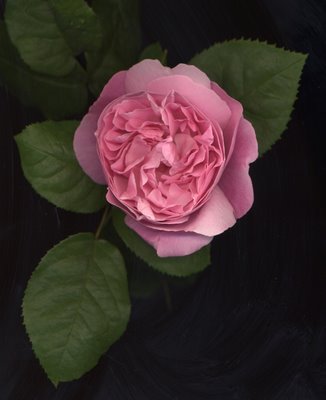
Rosa 'Mary Rose' made this blog before on June 20, 2006 but when I saw her yesterday afternoon as I watered the garden I had to bring her in for a scan.
In my early 20s when I was still more nerd-like than I am now I had a beautiful girlfriend in Buenos Aires called, Susy Bornstein. My Irish/Argentine cousins and nephews thought I was "funny" since I always showed up at parties alone. Just for once I was going to make a triumphant entrance with my gorgeous Susy. I chose a rugby game between the Buenos Aires rivals CASI (Club Atlético San Isidro) and SIC (San Isidro Club). My nephew Georgito was a star forward for CASI so here was my chance to show off my manly attraction and prove my family wrong. The fact is that none of my family ever met Susy as she always had an excuse for not showing up. My nephew Georgito had the suspicion that Susy was a figment of my imagination. I was not to learn until recently to make the connection with cats, babies and roses and that is that they never perform on demand.
The most often used excuse by Vancouver rosarians, when someone admires one of your rose bushes is, "You should have seen it yesterday before the rains."
My roses are perfect when I am alone with them in the garden. I smell them and pamper them and remove any leaf that may have a trace of black spot. Roses reduce my tension and stress and some years ago when I suffered terrible migraines I noticed that they diminished in late May and June which are the rose blooming months.
I feel a frustration much as I felt all those years ago that I cannot show off my roses in the same way I could not show off my Susy. I am unable to understand how my intoxication with roses finds no common ground with some of my friends. Even Rosemary sort of ignores my roses and puts her effort into her rather rare perennials. While she will admit that my hostas save the garden in August when none of her perennials have much to offer, she will not come out and tell me that the roses are important in our garden.
It was on Sunday that I went to Crystal Pite's work in progress at the Scotia Dance Centre. Here was a noted international dancer and choreographer giving an intimate performance to four of us. She seemed to be one of my roses. Why was it others did not take advantage of this opportunity (and it was free, too)?
This sheer pleasure that I cannot share brings bouts of loneliness which are most acute on a late and perfect afternoon in the garden as it was yesterday.
It ocurred to me that I have many pink roses. The average person would find them all the same. I have heard people comment on David Austin's roses, "So many of them are pink! They look the same."
But each pink rose when viewed not only for its colour and shape, noticed for the quality and sheen of its foliage or enjoyed for its individual scent, is impossible to confuse, one with another.
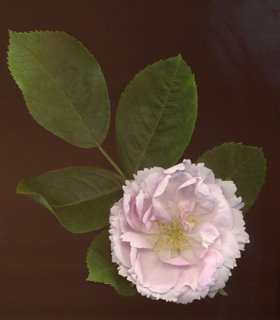
While my Susy was unique, perhaps a one of a kind Rosa 'Fimbriata' (right) who would not glory at showing up at a rugby game with 20 blondes in tow?
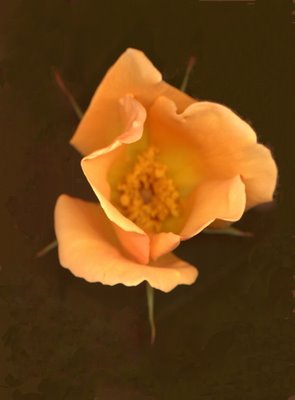
Some 7 years ago I visited eminent Vancouver rosarian Janet Wood at her Southlands garden. I spotted the rose you see here and asked her what it was. I remember distictly saying to Wood, "I am going straight home to make myself a pot of strong Earl Grey, I am going to butter (unsalted, cultured butter) two slices of toast and I am going to spread some apricot jam. I will do all this only after I place my order with you to get me Mrs. Oakley Fisher as soon as you can.
When I was a little boy my grandmother called me "el Príncipe de Gales" because of my uppity tendencies. When she wanted to pursue the matter further she would tell me I had been born to be a prince but somehow I had lost my way. My mother, all her life, would look at me and say, "Hay poca gente fina como nosotros." That losely translates to, "There are few people of breeding like us." My grandmother was a coloratura soprano but never sang professionally because people of her social standing never did stuff like that.
And so I have been saddled all my life with, "Naciste para príncipe, pero te quedaste en el camino."
How was I to know that my New Dublin born wife, Rosemary Healey, whose father was a carpenter would be just as uppity? And nowhere does this manifest itself more than in our garden. I have written here before how only recently did Rosemary allow me to have orange and yellow in the garden (all, of course, with moderation). But it was Rosa 'Mrs Oakley Fisher' that brought down the yellow barrier for her and she feels as much affection for this single (five petals) hybrid tea rose as I do.
Most of the roses in our garden were recommended by Janet Wood (seen here holding Rosa 'Dainty Bess' a classy single hybrid tea, with Dennis Yeomans, a Chilean born Vancouver rosarian who writes about roses exquisitely). Her easy going, down-to-earth manner does not readily reveal that she has not only a good eye for roses but she also has a bit of my mother's "gente fina". She has very good taste for roses.
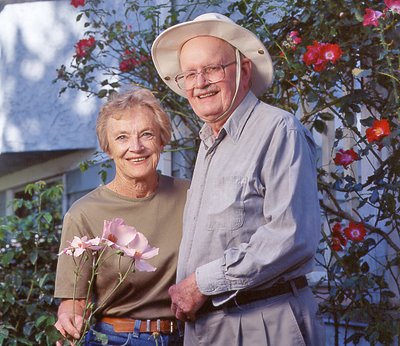
It is most fashionable to have old roses or English roses in the garden. It is fashionable to have obscure gallica's and hybrid musks. These I have. But a true garden snob will have one hybrid tea rose. It has to be Rosa 'Mrs Oakley Fisher', of course.
She was bred by Colchester rose man Benjamin Cant in 1921. The specimen you see here I brought in from the garden this morning to scan.

The houses were detached with large front lawns. Children were playing. There were no fences or walls between the houses. As a young boy living in Mexico, bardas and paredones (walls and big walls) were the rule. I had never seen anything like this. I saw red Flyer wagons and strange bicycles with thick tires. I am not sure if subsequent exposure to the Saturday Evening Post confused my memory. I am almost sure I saw a Dalmatian and a Cocker Spaniel running with the kids. This was Laredo, Texas, June 29, 1955 and I was 12 years old. My mother bought me a Revell plastic kit of what was a circa mid 50s Chevrolet truck. I was in heaven. It was my first venture into the United States of America. I have been an Ameriphile since. I had yet to note the significance that this first venture was through Texas.
This first entry into the United States was the realization of a dream that had started in Buenos Aires through my mother's connection to Americans by virtue of her job at the local American Grammar and High School. We were lower middle class but as her son I had free tuition so I attended the grammar school from kindergarden onwards. It was in that school where I made friends with Americans and first discovered Bazooka and Double Bubble, Gene Autrey and Roy Rodgers cap pistols and those impossible to get Lee jeans. We Argentines were starved and obsessed for American products. I remember with an absolute certainty a huge ad for Cemento Portland in the Retiro train station that had in parenthesis (USA) after every mention of the product. It would have seemed that Argentines and Perón depended on this great product to go forward on those Five-Year-Plans.
My mother brought stuff from school. I remember my first package of lime Jell-O, my first taste of a poppy seed bagel, and that Erector set that I received on Christmas made all my Argentine friends jealous.
I had a distorted view of my mythical country. I remember showing pictures to my friend Mario Hertzberg of wide-shouldered norteamaricanos who lived on a an island called Columbia. This island was protected by a very large statue of a woman holding a torch. This confused idea of mine had come (I realize this now) from an article in Life magazine about Columbia University ( its football team) and its proximity to the Statue of Liberty since the university is in New York City.
One of my mother's friends was the assistant (to the American Consul. The assistant and his wife would visit us in their baby blue 1950 Ford. When they parked this car at the front of my house I was the king of my Coghlan neighbourhood.
That first entry into the US through Laredo was one of several other short visits that my mother and I made. To get our Mexican residency (we had moved from Buenos Aires in 1954) we needed to leave Mexico and come back. This archaic and expensive bureacratic method still lives on in many countries.
While living in Nueva Rosita , Coahuila where my mother taught at the one room school house of the American Smelting and Refining Company school for the children of its engineers we made frequent visits to Eagle Pass (prounounced Eeglay Pass) by crossing from Piedras Negras, Coahuila. I remember most fondly the Eagle Pass Hotel that was decorated with Remington rifles and portraits of John Wayne. In Eagle Pass I sqandered $5.00 American Dollar bills (my special allowance) on Revell and Monogram plastic model kits. I had a huge collection.
These visits and my subsequent 4 years at St. Edward's High School in Austin, Texas managed to erase whatever ideas I had about being either an Argentine or a Mexican. I became an American. I became an American because I chose to be one. I felt American and even to this day I can claim that part of me is American. When you are in an American school and you study civics, you learn the workings of the three branches of the American federal government and even the details on the differences between misdemeanors and a felony it is difficult to "fight" the system.

It was difficult to fight this system when I visited the nearby Bergstrom US Air Force Base and ran my hands on the sharp edge of a Lockheed F-104 Starfighter or gazed up on the gigantic tail of a Boeing B-52 Stratofortress. It is only today that I notice or remember its name, The City of Austin.
It was difficult not to feel American when I heard the F-101 Vodoos streak above our neo-Gothic main building knowing (so we had heard io on Radio KTCBC, now KLBJ!) that one of them had fired a rocket that had flown up the tailpipe of a Russian Mig in Korea and downed it in a flash.

It was difficult not to feel pride in being an American when I saw our Catholic White Hope, Senator Kennedy debate Vice-President Richard Nixon on TV.
On the Easter holidays of my first year at St. Ed's my mother had scraped up enough money to send me on a school-sponsored trip (we went in a rented Grehound Scenicruiser!) to Washington, DC.

I have memory of shaking hands with a tall man with large hands and large ears. He gave me a card which I promptly threw away. It was a card that certified that I (my name was written on it) I had attended a hearing at the US Senate Chamber. It was signed by our Texas senator, Lyndon Johnson. The B of the LBJ was not to surface until John Kennedy became JFK. It was in DC where I bought my first serious camera, and Agfa Silette type 1 at a pawnshop. I asked for film and I remember that the druggist said, "Try Kodak Tri-X, it's the best film we carry." To this day, even though they have stopped the manufacture of many of my favourites, i shoot the film in from those familiar bright yellow and blue boxes.
Looking back on this all as Rosemary and I prepare our July 15 trip with Rebecca to Mérida, Yucatán via Austin, Texas I can feel that this American part of me is a bit less American and lot more Texan. It was living and growing up in Texas, falling for my first sweatheart Judy Reyes that was so important in my becoming who I am today. Those long bus trips from Nueva Rosita to Austin, took me on Continental Trailways Flxible buses that passed through Texas towns like Carrizo Springs, Del Rio, Uvalde, Crystal City (the first US city with an elected official of Mexican heritage) on its way to San Antonio. There I would board one of those exceedingly handsome and magical Greyhound Scenicruisers that seemed to fly on the Texas concrete-made expressways (as Texans call freeways) which were part of President DwightD. Eisenhower's legacy to the US. These expressways started the American dependancy on the automobile. I remember that both Bing Crosby and Bob Hope appeared in large Life Magazine ads that trumpeted the advantages of concrete freeways.
Those lonely (it was always sad to leave home after the Christmas holidays to head to the bleak, cold and rainy Austin winters) bus trips were through stark Texas landscape of mesquite and desert with the occasional flash floods that made dry river beds suddenly look like small oceans. I first became used to that Texas landscape, and then without knowing I absorbed it so that I now anticipate with tremendous pleasure being able to see it soon.
Near Austin we will visit my friend Howard Houston and his wife Lynne. We will eat all kinds of Texas barbecue and Tex-Mex food. But principally we will visit our old St. Ed's and hug Brother Edwin Reggio CSC who was there with us and was a key element in our transition from boyhood into manhood.
But he had nothing to do with the fact that today I am a Canadian citizen born in Buenos Aires who feels very Texan. I feel Texan enough to know that the US has had two Texas born presidents. That second one, the one you probably cannot remember, was born in Denison, Texas. That's Dwight David Eisenhower.
Dr. Kevin Vaughn's Concord Grapes
Saturday, June 09, 2007

It was perhaps 6 or 7 years ago that I spotted a tall man with glasses at the Burrard door of the Vancouver Hotel. I went up to him and said, "How are you Dr. Vaughn? What are you doing in Vancouver?" He looked at me; thought about it and answered, "Hi, Alex I am here for botanical conference representing the US Department of Agriculture.My specialty is weeds."
In the late 70s and early 80s Kevin Vaughn was fascinated by hostas which are kind of the white mice of plants. Changes happen more quickly, they mutate with more frequency. Perhaps Vaughn saw in hostas a way of studying plants but in an accelerated more information could be obtained in less time. For his doctorate Vaughn wrote a treatise on the theory of how plants (and hostas in particular) variegate. He wrote these very important publications with K.G. Williams:
Chloroplast Mutants in Hosta
Genetics and Ultrastructure of a Dotted Leaf Pattern in Hosta.
An Ultrastructural Survey of Plastome Mutants of Hosta
From hosta Dr. Vaughn directed his research interest into Hemerocallis (daylillies).
Perhaps some 6 years ago I brought home some Tradescantia x andersoniana 'Concord Grape' for Rosemary. Tradescantias, named after John Tradescant, and English horticulturist and botanist have stems than when cut ooze a viscous secretion that hardens to form a silky web. This is why they are commonly called spiderworts.
Rosemary looked at my gift with doubt. Tradescantias remind me of the bird of prey space ships of Star Treck but Rosemary dislikes them because they flop over and look messy and the spent flowers (white in our garden)get rusty coloured.
Tradescantia x andersoniana 'Concord Grape' accurately named for the rich purple colour of their flowers surprised Rosemary by not flopping, blooming from late spring into fall and not only that, the spent blooms were tidy and beautiful.
Today I was surprised to discover that this plant is a Dr. Kevin Vaughn introduction. Some tradescantias are listed as weeds so perhaps in his research he decided to pass these on to us! Rosemary is grateful. And yet another plant in my garden has a human face behind it.
Through My Kitchen Door
Friday, June 08, 2007


Since the 1950s I have eschewed air travel when Pan Am stewardesses handed out Juicy Fruit gum on Lockheed Super Constellations and metal detectors were used only for beachcombing. Now I prefer to get away in bed or by opening my kitchen door and venturing into my garden. Through association, just about every plant will take me elsewhere, often to another time and, more often than not, remind me of a person, too.
I have been giving thought to the above as my eldest daughter Ale is moving to Lillooet to live in July. "Papi, " she told me, "I bought the property up there so that you and Mami can get away." The trip each way is 4 hours and on a weekend, whatever relaxation we would enjoy it would be contrasted with the agony and stress of having to drive back on a Sunday on the Freeway 1 or the more dangerous Sea to Sky Highway. Rosemary is most upset and we wonder how many times we will go to visit. By the time Ale understands our philosophy of travel we will be perhaps long gone.

I remember as a child of 6 or 7 in Buenos Aires that I would go to our backyard "galpón" or shack were my father kept some old but very large wooden crates. In one I would place three bricks (gas pedal, brake, clutch), which I would lean on a thick board at my feet. Sitting on a smaller box in the middle of the crate and I would hold one of our dinner plates. It was my steering wheel. In seconds I was Juan Manuel Fangio, driving through the muddy roads of Argentina's interior.

In the same way a plant propels me elsewhere. My Hosta 'Sieboldiana Elegans' whisks me to Japan. It was named for Philipp Franz Balthasar von Siebold, a German doctor who worked for Dutch traders on Dejima Island in Nagasaki harbour. Foreigners were not allowed on the mainland, so von Siebold would scour fodder sent to feed the livestock in hopes of finding unusual plants. That's where he saw his first hosta in 1823.

Another hosta, a bright yellow, green and white variegated Hosta 'Fortunei Albo Picta' beneath a white Camellia japonica , was named for Scottish plant hunter Robert Fortune. Because Camellia japonica is closely related to Camellia chinensis, the tea bush, it reminds me of Fortune's voyages in the Far East. In 1848 he traveled to China (dressed as a Chinese potentate and carried around in a litter) to spy on the cultivation of tea for the East India Company. Soon the British grew tea in India.

My Rosa 'Redouté'is an English Rose but it has ties to France. Redouté was the artist hired by Empress Josephine, an avid plant collector, to imortalize the roses in her famous garden at Malmaison. My thistles, Echinops ritro , and the taller thistle-like cardoon Cynara cardunculus , make me homesick for the Argentine pampa where I was raised. Charles Darwin describes the pampas in Voyage of the Beagle: There were immense beds of the thistle as well as of the cardoon: the whole country, indeed, may be called one great bed of these plants."

Sometimes I need only to travel to the kitchen, where a potted Pelargonium 'Vancouver Centennial' on the windowsill carries me away to Lima, Peru. In an interview with Peruvian novelist Mario Vargas Llosa in 1990, I asked him why his novels had frequent descriptions of potted pelargoniums (pelargoniums are commonly called geraniums but that is incorrect. While they are related, the true geranium, the crasnesbill geranium, is another plant altogether). Llosa explained that in 1499, Vasco da Gama brought the pelargonium from South Africa to Lisbon. It crossed to Exremadura in Spain. Then, whith Pizarro and Cortez, it sailed to the New World, finding a home in Lima's poor and sun-baked soil. "It thrives in adversity and neglect like our people," Llosa told me.

It is thanks to plant hunters, collectors and explorers that our gardens boast such botanical variety. We needn't suffer the vagaries of modern travel to experience the exotic world they explored. Now it is outside the kitchen door.

The photographs seen here are all pelargoniums (geraniums, if you will) in several areas of Lima, Peru.

Cadbury Chocolate Eggs, Monk Testicles, Napoleon and Finger Bananas
Thursday, June 07, 2007

One day, quite some time ago, I happened on a photograph of Napoleon's younger brother, Jerome, taken in 1852. And I realized then, with an amazement I have not been able to lessen since: "I am looking at eyes that looked at the Emperor." Sometimes I would mention this amazement, but since no one seemed to share it, nor even understand it (life consists of these little touches of solitude), I forgot about it.
Chapter 1 - Camera Lucida - Reflections on Photography
Roland Barthes
Ever since I stared at Timothy O'Sullivan's photographs of American Civil War soldiers (and telling myself, "They were alive when these photographs were taken.") when I was around 9, I have been fascinated by photographs of long-dead people. I share and understand Roland Barthes's amazement.
Looking out of my window as I write this I can see the almost white (with a deep yellow centre) single blooms of Rosa 'Dupontii'. My first impression makes me smile as they remind me of the Cadbury chocolate Easter eggs that Rosemary used to buy for Ale and Hilary (I would steal a few and eat them with pleasure) when they were little girls and we lived in Burnaby. A secondary thought is that I am looking at a healthy light green shrub (quite tall at 9 ft) decorated with perfect fried eggs.
This vision does not quite agree with my memory that Dupontii has the scent of a ripe banana. That brings to mind the bananas, banana shaped chocolate covered soft candy that we Argentines love to eat when we go to the movies or the theatre. Those bananas are called bananas in Argentina even though in Mexico and in Spain bananas are plátanos. The white soft filling of the Argentine chocolates smell like Dupontii.

My grandmother had a fondness for what Americans call finger bananas. She called them plátanos dominicos and they were sometimes available in Mexico City. Abue would eat them with peanut butter and jam. In retrospect I would guess that they were called Dominican bananas after Dominican priests (the feared order of the Spanish Inquisition). The name was an irreverent opinion on the perceived size of their sexual organs.
It was not only my grandmother who enjoyed the jelly filled (much bigger than the local but equivalent dougnut holes) suspiros de monja (nuns'sighs) but also called bolas de monje (monk's balls) I loved them, too, dunked in café con leche.
Rosa 'Dupontii' at one time was considered a species rose so it was called Rosa dupontii. But recent research has indicated that this single rose (5 petals but sometimes with a couple more) is a cross between R. gallica and R. moschata. It was named for André Dupont, director of the Luxenburg Gardens in Paris. It is a safe guess that it was raised there, in about 1817.
With further research I found out that Dupont was also a gardener at Empress Josephine's (Marie-Joseph-Rose-Tascher de la Pagerie) rose garden (over 250 varieties) at Malmaison.
Alas I cannot make a direct connection between Napoleon and my Rosa 'Dupontii' as the rose came into existence two years after Waterloo (1815). But of course the non connection is a connection nonetheless. Dupontii not only makes me think of Cadbury chocolate eggs, fried eggs, bananas, small bananas but now also of the Emperor himself. After all if Josephine gazed upon both the Emperor and at Dupontii then the connection is there.

Rosemary came back last week from visiting her sister in New Dublin, Ontario. She brought back her old piano sheet music that she is going to have Rebecca play. One of the sheets caught my eye.
Napoleon
Napoleon in Egypt
Nueva Rosita, Coke & Abraham Darby Times 3
Wednesday, June 06, 2007

Coke is a solid carbonaceous material derived from destructive distillation of low-ash, low-sulfur bituminous coal. The volatile constituents of the coal, including water, coal-gas and coal-tar, are driven off by baking in an airless oven at temperatures as high as 1,000 degrees Celsius so that the fixed carbon and residual ash are fused together.
Making coke, at least back in the mid 50s was a polluting endeavour but I never gave it much thought. In the mid 50s I lived with my mother in Nueva Rosita, Coahuila, a mining town where ASARCO (American Smelting & Refining Company) called the shots. I remember the first day I ever saw Nueva Rosita. We had landed, the day before in a DC-3 in a desolate airport (an airport because it had a dirt landing field that happened to have a shack with a revolving sock on the roof). This was Monclova, Coahuila which was the centre of the Mexican steel industry run principally by a company called Altos Hornos (high ovens). From Monclova we took a bus to Nueva Rosita. We arrived in the middle of the night but I remember seeing some lights and smoke that glowed in the dark cloudless sky. This was a high desert and I soon found out it rarely rained. When I woke up the next morning it was already around 38 degrees and I was bathed in sweat. I got up and looked out of the window. What I saw is what you see here even though I took this ancient Ektachrome and the b+w negative about three years later.

My mother explained that in Nueva Rosita they mined zinc and made coke. I never did ask what coke was but soon after I found out that coal was burned in an almost oxygen free oven and the coal was converted into a porous substance wich was used to make steel. I never did make the connection that our Nueva Rosita coke helped industrialize Mexico by contributing to the steel production of Monclova.
It is only yesterday that I made the complete connection thanks to an English Rose, Abraham Darby, that has begun to bloom in my garden. This 1985 introduction by David Austin does not smell of myrrh like so many of my roses. It has an intense perfume of fruit and old roses. I should have obtained this lovely rose a long time ago. I finally did.
I looked up Abraham Darby (1678-1717). It seems that by the end of the 17th century England was running out of forests to cut down to make the charcoal that was then used to smelt iron. It was around 1709 that Darby successfully used coke as fuel to smelt iron at his ironworks in Coalbrookdale in Shropshire. England had plenty of coal, from which coke was made.

Darby's process helped usher in England's industrial revolution. Darby's grandson, Abraham Darby III (1750 - 1791) constructed the world's first iron bridge, over the Severn river at Coalbrookdale, Shropshire in 1779.
When I crossed the iron bridge in Shropshire I did not give it much thought nor did I stop at David Austin's rose nursery. This was 1987. I might have run into Rosa 'Abraham Darby' at Austin's nursery. But I didn't know much about roses then. I wasn't even interested in them.

Last night when I brought in a couple of my Abraham Darby blooms, the intense perfume cleared my mind like Keen's Mustard and Nueva Rosita (small new rose), coke, iron, steel, the old iron bridge I had crossed back then, and David Austin's rose all came together and made a lot of sense. Pity my mother is not around. "You know mother, there is this rose and........"
Pristine, Cool, Crisp, Elegant (But Otherwise Ordinary) Hostas
Tuesday, June 05, 2007


A few days ago in the late evening (8pm) I took some pictures of my emerging garden. It is in the waning days of May that hostas look their crisp best. The nicest feature of the hostas in these photographs is that most of them are ordinary hostas except for my prima donna Hosta 'June' that demands I photograph her whenever I look in her direction. She is always perfect and her perfection does not fade until September when most of my other hostas and perennials show the wear and tear of spent blooms, bug and slug damage and are ready to call it a year.
Top left you see Hosta 'Krossa Regal' with Kirengeshoma palmata . Right is Hosta 'June' with Osmunda regalis (Royal Fern) to her right. Behind left is Hosta 'Gold Regal', not quite gold/yellow yet as the colouring happens in July. To June's right is an extremely ordinary and old hosta, so old that it is difficult to now get her in the local garden trade.

She is Hosta 'Antioch'. She measures five feet across and you can see more of her, left. Behind Osmunda regalis is the cinnamon fern, Osmunda cinnamomea.
Sometimes it pays to play with a new camera that is not too familiar. The last picture seen here measures 4 inches across in its original size. The pictures taken by my German swivel lens panoramic, the Noblex 175 should be 7 inches across. I was ready to see Horst until I figured out that I had loaded the Noblex incorrectly.

Cliff Robertson, Neil Armstrong & The Queen Of Denmark
Monday, June 04, 2007

Many know exactly where they were and what they were doing the day that US President, John F. Kennedy was assasinated in Dallas. I know exactly where I was and what I was doing but I also know the coordinates for another important moment in our history. On July 20, 1969 at 10:17:42 (actually 9:17:42 as Mexico City did not have daylight saving time) when Neil Armstrong stepped on the moon, I shut off our TV in our Mexico City apartment and told Rosemary we were going to the movies.
When I photographed actor Cliff Robertson in Whistler, BC sometime in the late 80s I told him about my experience in seeing him play Charly in the 1969 Ralph Nelson film by of same name. I had read in 1964, Daniel Keyes's 1960 novel Flowers for Algernon (extended to novel form from his earlier novella) from which Charly's screen play was based on. Charly, the story of a retarded man who is chemically made intelligent but regresses back to his earlier state, while being lovingly cared for by Claire Bloom was a film I was not going to miss back in 1969. I had been married to Rosemary for a year but I still remembered one of my first girlfriends (1964) Judy Brown who looked like Claire Bloom. I simply saw all Claire Bloom films and still do. Besides I was a sucker for this sort of film as I then enjoyed Terence Stamp (who wakes from a coma after 30 years)in The Mind of Mr Soames. In this film Terence Stamp starts as a fully grown baby who very quickly learns to be an adult.
Because of the moon landing, Cine Polanco, where Rosemary and I saw Charly, was virtually empty. It made the tragic movie all that more poignant for us. I remember leaving the empty movie house completely drained with no memory of the event of the day that was unique to the human race. From that day on we could uniquivically think, "We (from the vantage point of the moon) are from there (pointing at the blue circle looming over the moon's horizon)!
There was one aspect of the film that would come to haunt me and almost offend me years later when around 1976 while watching TV in Vancouver I saw a commercial seeking money to research dyslexia. I was a dyslexic and I had never known. The Charly posters and the title of the film had that r reversed. It now almost offends me as much as Toys Я Us.
In 1970 we institutionalized my grandmdmother Lolita who progressively took baths and got ready for bed earlier and earlier during the day. One day she came back from seeing her son Tony (my Uncle Tony) in Egypt and she did not recognize who we were. This was my introduction to Alzheimer's. Since then I have known several close friends who have had to face this disease in their family.
On a purly objective look at Alzheimer's (ignoring the suffering of those who must live with family members who increasingly become violent) I find it an almost reversely symmetrical fading out of our existence that parallels our gradual fading into memory from birth. I remember being 6 but not before.
When Rebecca was 5 and we took her to Washington DC to the American Hosta Society National Convention she played the a game of naming (in rapid succession) hostas connected to women with a woman who sported a convention tag on a DC Rapid Transit car. She fired off, Hosta 'Marilyn', Janet, Mildred Seaver, June and on. I was dazzled but I kept telling Rosemary, "If we were to die today, Rebecca would not rmember us at all."
I have been noting with interest( Why did I not note this with my two daughter's?) how Rebecca's memory seems to work. She has an excellent memory but the names of plants she knew well three years ago I must now reinforce as she has forgotten. Her mental process seems to mimic that terrible computer process by which sometimes when you write emails or in Word, and when you go back to correct mistakes, the insertion of the correction removes (gobbles up) the letters after it. A similar situation would be the running of a locomotive on a few set of tracks in which the forward path would be laid with tracks from ground covered that far.
Yesterday I went to Rebecca's and we mixed alfalfa meal with magnesium sulphate (epson salts) and watered her roses (Rosa 'Mary Magdalene', Tuscany Superb, Mrs. Oakley Fisher, The Fairy and Popcorn ). We removed all the dead wood and leaves that had black spot. It was then that I was startled by a request.
"Papi, I really want Königin von Dänemark." Now Queen of Denmark is a brand new rose (an 1826 Alba) in my garden and it has yet to bloom. Twice in the last few weeks Rebecca has asked me to show her the rose bush as I had yet to find a spot for it. And when I did Rebecca did not know where it was. This rose has sparked her not quite fading interest in roses. I will have to buy her one.

Charly, Mr. Soames, Rebecca: It is fascinating to watch the building up of memory so close at hand.
Addendum: Cliff Robertson's overall green/cyan cast is due to the colour negative's deterioration from the mid 80s. If I were to remove the green/cyan cast from the picture, Robertson's face would warm up beyond reality. This is an example of a photograph that can only be "improved" with extensive Photoshop restoration which is presently beyond my scope of expertise.
The Making Of A Snob - Part II
Sunday, June 03, 2007

To anybody who might be a faithful reader of this, and if you don't have a passing interest in roses, you may have to search for something else to while away the next few summer days. I am convinced that my relationship to roses helps me understand the world and the people I interact with. I am convinced that roses reveal to me my many flaws but at the same time they (the roses) gently offer corrections that just might make my relationship with others a bit better.
To continue on this subject of being a plant snob
 I must state that while I am dead serious there is also a bit of whimsical lightness in it. Take for example the three roses featured today. Of the first, the little five-petalled single, the species rose Rosa glauca Roger Phillips and Martyn Rix in their Random House Guide to Roses write:
I must state that while I am dead serious there is also a bit of whimsical lightness in it. Take for example the three roses featured today. Of the first, the little five-petalled single, the species rose Rosa glauca Roger Phillips and Martyn Rix in their Random House Guide to Roses write:Rosa glauca , Pourret ( R. rubrifolia Vill) A tall shrub up to 4 m with support but usually with arching branches and few thorns, easily recognized by its very grey or sometimes purplish leaves, and small deep pink flowers. Hips brownish red. Native of the mountains of Central Europe, from the Pyrenees and Alps eastwards to Poland, Romania and Albania, but not common. Introduced into cultivation in England before 1830, this rose has recently become excessively popular for its foliage, both in a garden setting and for use in flower arrangements. Beautiful specimen bushes grow on the terrace of Crathes Castle in Aberdeen.
Seen with Rosa glauca in my scan is David Austin's English Rose, Rosa 'St Swithun'. The highly scented (of myrrh) blooms are 4½ inches wide and my bush blooms most of the summer. The third rose is a classic rose, Rosa 'Fantin Latour'of which little is known. Peter Beales writes in his Classic Roses :
A superb mystery rose with records conspicuously absent. The soft delicate pink flowers and their form place them here (Centifolias[Provence Roses, Cabbage Roses] -Forms and Hybrids), although its foliage is smoother, darker green and more rounded than is typical. Its shoots too are less thorny. I find the all-pervading perfume rather more Alba-like than Centifolia. One theory of its origin suggests that it was once used as an understock, but since it does not root readily from cuttings, at least for me, I think this unlikely.
From the point of beeing a practical gardener one would say that the best rose here is Rosa 'St Swithun' as it has very large, beautiful and extremely fragrant blooms which occur from June to fall. Rosa glauca blooms only once and the flowers are only lightly scented and quite small. Fantin Latour flowers are 3 inches wide, they are scented but they appear only once in early June and that's it for the season.
Some snobs (and I know a few of these) keep their Rosa glaucas pruned severely (they get almost no flowers) but the foliage of these specimen plants is fresh and the leaves develop that prized and snobbish glaucous green. I would like to add that that Rosa glauca immediately develops hips (right after the blooms) that are the colour of Hershey milk chocolate!
The scans you see here are all from flowers I cut today from plants in my garden. This snob has chosen to have all three for different reasons. I have been rewarded in my choice democracy by discovering (after a 7 year wait) that Rosa 'Fantin Latour' when allowed to grow to about 7 ft will become extremely shade tolerant. In my garden where I have a heavy tree canopy this is a definite plus. And this is true even if a true plant snob would point out that Fantin Latour's leaves are a bit too big in proportion to the size of bloom.
Rosa glauca appeals to my Rosemary who may be more of a snob (or at least in the direction of plants that may have blue in them and are not immediately showy) than I am. We have to very large specimens which never show any disease.
Now St Swithun is special for me because it was the last rose Rosemary ever showed a keen interest in. She lost this interest, outwardly at least, as soon as I became enamoured with roses. Some 7 years back Rosemary spotted St Swithun at the VanDusen Garden Show and she told me she had to have it. It was a display plant at a nursery booth so she went early on the last day and put a hold on it. We brought him home and it rained for a week. It rained so much that it made the news.
I investigated the story behind St Swithun and this is what I found out. St Swithun is apparently the saint to blame for rainy summers. It is said that if it rains on his special day, 15 July, it will then rain for forty days after that.
It all began when he was made Bishop of Winchester in 852 by King Ethelwulf of Wessex. Winchester was the capital of Wessex, and during the 10 years Swithun was there, Wessex became the most important kingdom of England.
During his life, instead of washing out people's summer holidays, and damping down their spirits, Swithun seems to have done a lot of good. He was famous for his charitable gifts and for his energy in getting churches built. When he was dying in 862, he asked that he be buried in the cemetery of the Old Minster, just outside the west door.
If he had been left there in peace, who knows how many rainy summers the English may have been spared over the last 1000 years. But, no, it was decided to move Swithun. By now, the 960s, Winchester had become the first monastic cathedral chapter in England, and the newly installed monks wanted Swithun in the cathedral with them. So finally, on 15 July 971, his bones were dug up and Swithun was translated into the cathedral.
That same day many people claimed to have had miraculous cures. Certainly everyone got wet, for the heavens opened. The unusually heavy rain that day, and on the days following, was attributed to the power of St Swithun.
Swithun was moved again in 1093, into the new Winchester cathedral. His shrine was a popular place of pilgrimage throughout the middle ages. The shrine was destroyed during the Reformation, and restored in 1962.
It would seem that being able to have all three roses in my garden would represent a botanical version of learning to live with one's friends. If being a plant snob creates this situation then we should all grow Rosa glauca and when visitors come to your garden, like Rosemary you would say, "The flowers are insignificant but isn't the foliage lovely?"
Rosa 'Mary Rose' Redux
Saturday, June 02, 2007

Rosa 'Mary Rose' made this blog before on June 20, 2006 but when I saw her yesterday afternoon as I watered the garden I had to bring her in for a scan.
In my early 20s when I was still more nerd-like than I am now I had a beautiful girlfriend in Buenos Aires called, Susy Bornstein. My Irish/Argentine cousins and nephews thought I was "funny" since I always showed up at parties alone. Just for once I was going to make a triumphant entrance with my gorgeous Susy. I chose a rugby game between the Buenos Aires rivals CASI (Club Atlético San Isidro) and SIC (San Isidro Club). My nephew Georgito was a star forward for CASI so here was my chance to show off my manly attraction and prove my family wrong. The fact is that none of my family ever met Susy as she always had an excuse for not showing up. My nephew Georgito had the suspicion that Susy was a figment of my imagination. I was not to learn until recently to make the connection with cats, babies and roses and that is that they never perform on demand.
The most often used excuse by Vancouver rosarians, when someone admires one of your rose bushes is, "You should have seen it yesterday before the rains."
My roses are perfect when I am alone with them in the garden. I smell them and pamper them and remove any leaf that may have a trace of black spot. Roses reduce my tension and stress and some years ago when I suffered terrible migraines I noticed that they diminished in late May and June which are the rose blooming months.
I feel a frustration much as I felt all those years ago that I cannot show off my roses in the same way I could not show off my Susy. I am unable to understand how my intoxication with roses finds no common ground with some of my friends. Even Rosemary sort of ignores my roses and puts her effort into her rather rare perennials. While she will admit that my hostas save the garden in August when none of her perennials have much to offer, she will not come out and tell me that the roses are important in our garden.
It was on Sunday that I went to Crystal Pite's work in progress at the Scotia Dance Centre. Here was a noted international dancer and choreographer giving an intimate performance to four of us. She seemed to be one of my roses. Why was it others did not take advantage of this opportunity (and it was free, too)?
This sheer pleasure that I cannot share brings bouts of loneliness which are most acute on a late and perfect afternoon in the garden as it was yesterday.
It ocurred to me that I have many pink roses. The average person would find them all the same. I have heard people comment on David Austin's roses, "So many of them are pink! They look the same."
But each pink rose when viewed not only for its colour and shape, noticed for the quality and sheen of its foliage or enjoyed for its individual scent, is impossible to confuse, one with another.

While my Susy was unique, perhaps a one of a kind Rosa 'Fimbriata' (right) who would not glory at showing up at a rugby game with 20 blondes in tow?
Rosa 'Mrs. Oakley Fisher' & The Making Of A Snob
Friday, June 01, 2007

Some 7 years ago I visited eminent Vancouver rosarian Janet Wood at her Southlands garden. I spotted the rose you see here and asked her what it was. I remember distictly saying to Wood, "I am going straight home to make myself a pot of strong Earl Grey, I am going to butter (unsalted, cultured butter) two slices of toast and I am going to spread some apricot jam. I will do all this only after I place my order with you to get me Mrs. Oakley Fisher as soon as you can.
When I was a little boy my grandmother called me "el Príncipe de Gales" because of my uppity tendencies. When she wanted to pursue the matter further she would tell me I had been born to be a prince but somehow I had lost my way. My mother, all her life, would look at me and say, "Hay poca gente fina como nosotros." That losely translates to, "There are few people of breeding like us." My grandmother was a coloratura soprano but never sang professionally because people of her social standing never did stuff like that.
And so I have been saddled all my life with, "Naciste para príncipe, pero te quedaste en el camino."
How was I to know that my New Dublin born wife, Rosemary Healey, whose father was a carpenter would be just as uppity? And nowhere does this manifest itself more than in our garden. I have written here before how only recently did Rosemary allow me to have orange and yellow in the garden (all, of course, with moderation). But it was Rosa 'Mrs Oakley Fisher' that brought down the yellow barrier for her and she feels as much affection for this single (five petals) hybrid tea rose as I do.
Most of the roses in our garden were recommended by Janet Wood (seen here holding Rosa 'Dainty Bess' a classy single hybrid tea, with Dennis Yeomans, a Chilean born Vancouver rosarian who writes about roses exquisitely). Her easy going, down-to-earth manner does not readily reveal that she has not only a good eye for roses but she also has a bit of my mother's "gente fina". She has very good taste for roses.

It is most fashionable to have old roses or English roses in the garden. It is fashionable to have obscure gallica's and hybrid musks. These I have. But a true garden snob will have one hybrid tea rose. It has to be Rosa 'Mrs Oakley Fisher', of course.
She was bred by Colchester rose man Benjamin Cant in 1921. The specimen you see here I brought in from the garden this morning to scan.






